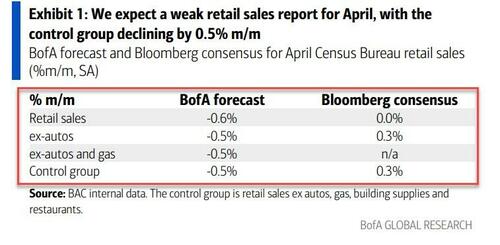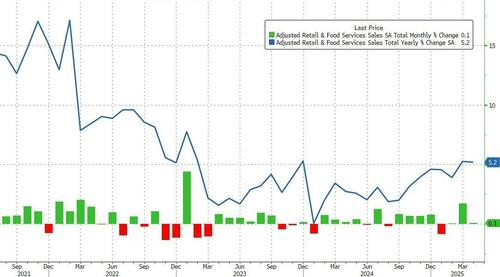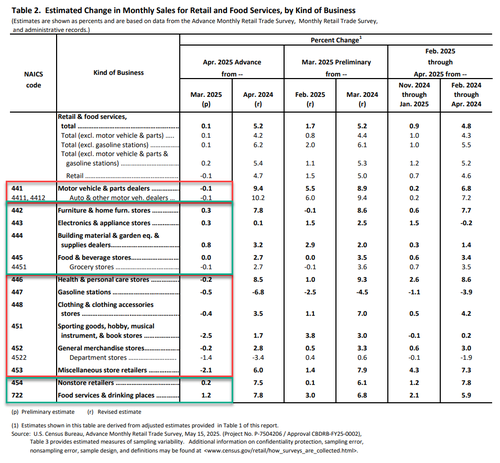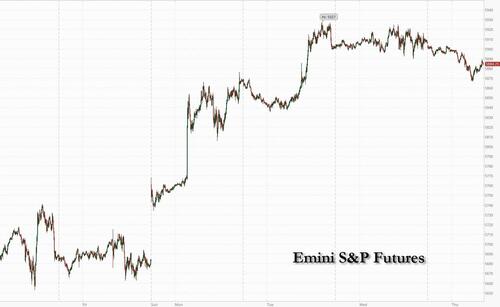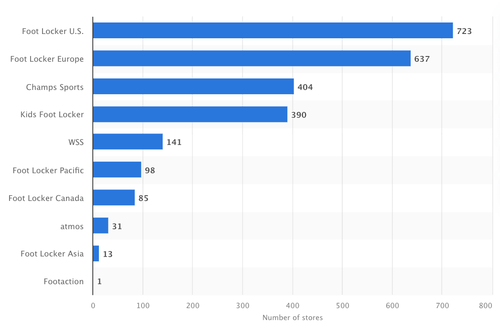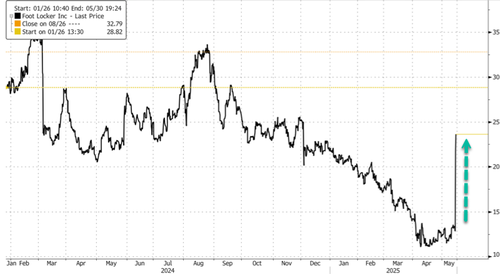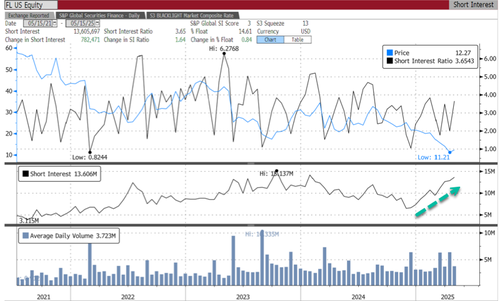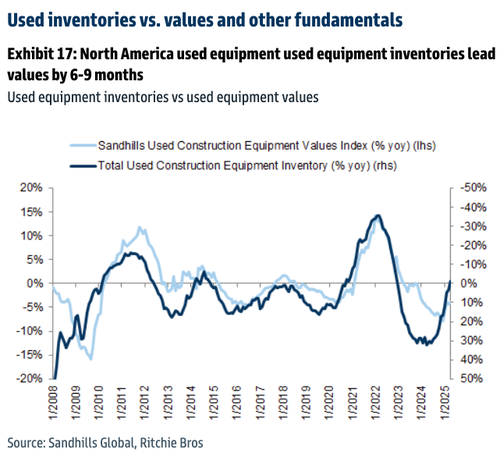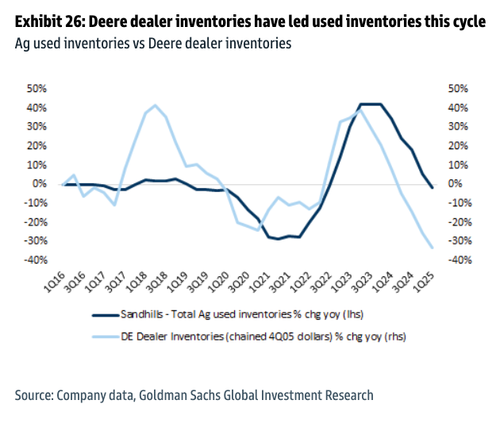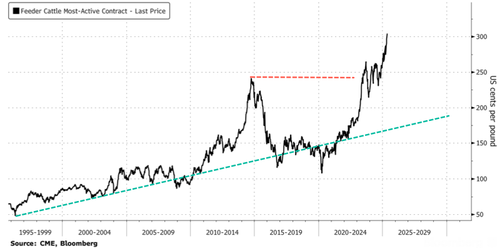No one is forced to be a Christian. But no one should be forced to live according to the "new religion" as though it alone were definitive and obligatory for all mankind.
Distinction Matter - Subscribed Feeds
-
Site: Zero HedgeUS Retail Sales Surprises To The Upside, But...Tyler Durden Thu, 05/15/2025 - 08:41
If BofA's omniscient analysts are right (and they have been serially on the correct side of this data series relative to consensus for months), then traders should brace for disappointment this morning for the retail sales data.
But...
For once, the BofA analysts were incorrect as headline retail sales rose 0.1% MoM (better than the 0.0% MoM exp, but this follows a sizable upward revision in March to +1.7% MoM (from +1.4%). With the revision that left retail sales up 5.2% YoY - near its highest since Dec 2023
Source: Bloomberg
Under the hood, Sporting Goods sales declined the most while Building Materials rose the most...
The (tariff front running) surge in Motor Vehicle Sales last month has gone...
Source: Bloomberg
As a reminder, this data is nominal, so adjusting ()very roughly) for inflation, retail sales rose 2.8% YoY, equalling its highest since Feb 2022...
Source: Bloomberg
More problematically, the Control Group - which feeds directly into GDP - was a big miss, dropping 0.2% MoM (vs expectations of a 0.3% MoM rise)...
Source: Bloomberg
So, the good news is bottom-up Americans are spending... but top-down GDP may be negatively affected.
-
Site: AsiaNews.itThe arrest of Istanbul's mayor has reversed the positive course the country had embarked upon. A study by the EBRD confirms that boycotts and protests have disrupted efforts to curb inflation, triggering "turmoil". In April, the Central Bank raised interest rates after months of holding steady. New arrests among university students have followed clashes with police.
-
Site: LifeNews
Health and Human Services Secretary Robert F. Kennedy, Jr. said Wednesday that he has ordered a top-down review of the abortion drug mifepristone in light of “alarming” research showing the Food and Drug Administration (FDA)-approved pill does far more harm to women than previously reported.
The latest research is “alarming,” Kennedy said during a hearing before the Senate Health, Education, Labor and Pensions Committee. “And clearly it indicates at the very least the [FDA] label should be changed.”
“I’ve asked Marty Makary, who’s the director of the FDA, to do a complete review and to report back,” Kennedy added.
Please follow LifeNews on Rumble for the latest pro-life videos.
A new study on the chemical abortion drug shows 11% of women experience adverse effects serious enough to send them to the ER@SecKennedy just pledged to conduct a top-to-bottom review of the drug – and said the FDA label needs to change
That’s a win for life pic.twitter.com/gy65iCZjI5
— Josh Hawley (@HawleyMO) May 14, 2025
As Dr. Susan Berry reported for CatholicVote April 28, a “bombshell study” by the Ethics and Public Policy Center (EPPC) “revealed nearly 11% of women experience severe or life-threatening complications after an abortion via the drug mifepristone – a rate that is 22 times higher than indicated on the drug’s label approved by the federal Food and Drug Administration (FDA).”
EPPC “analyzed 865,727 mifepristone abortions that occurred between 2017 and 2023, a number that is ‘28 times larger than in all FDA clinical trials combined,’” Berry reported.
CatholicVote reported the following day that the Catholic advocacy group had “joined a coalition of over 30 pro-life organizations Tuesday in urging the Trump administration to evaluate the Food and Drug Administration’s (FDA) approval of the abortion drug mifepristone, immediately following the release of a new study revealing serious health risks.”
The coalition letter argued “that mifepristone—used in over 60% of US abortions—was irresponsibly approved in 2000 and continues to harm women.”
“We respectfully ask that you take swift action to protect the rights of states to defend unborn children, in keeping with your campaign pledge to return the issue of abortion to the states,” the letter read, calling on the administration to stand firm “as a defender of the weak and vulnerable.”
LifeNews Note: Joshua Mercer writes for CatholicVote, where this column originally appeared.

The post HHS Secretary Robert Kennedy Will Investigate Dangerous Abortion Pill appeared first on LifeNews.com.
-
Site: Zero HedgeZelensky In Istanbul Responds To 'Insult' Of Putin Sending Junior Officials To Talks: "I Am Here"Tyler Durden Thu, 05/15/2025 - 08:30
A team of Russian negotiators are in Istanbul on Thursday for the first direct peace talks with Ukraine in more than three years, with Russia's Foreign Ministry officials saying that the delegation is "ready for serious work".
President Putin, who as expected is not there in person, tapped his aide and former culture minister Vladimir Medinsky to lead the talks, which many Western analysts have claimed is an 'insult' given it's not someone more senior. Medinsky, it should be remembered, oversaw the failed 2022 peace talks with Kiev in the weeks after the February invasion.
Alongside Medinsky are Deputy Foreign Minister Mikhail Galuzin, Deputy Defense Minister Alexander Fomin and Igor Kostyukov, the head of Russia’s military intelligence agency (GRU).
Supporting these main negotiators are group of advisers, including senior officials from the Foreign and Defense Ministries, along with Putin aides. The Kremlin confirmed the identities of its negotiating team by releasing footage of Putin meeting with the negotiation group late Wednesday.
On Wednesday evening, Russian President Vladimir Putin held a meeting to discuss arrangements for talks with Ukraine, due to take place today in Istanbul, Kremlin Spokesman Dmitry Peskov told reporters:https://t.co/hRmXK7daoA
— TASS (@tassagency_en) May 15, 2025
Video: Kremlin. ru pic.twitter.com/1e7DHMlFgvOther top officials were seen present in the send-off meeting in Russia, among them Defense Minister Andrei Belousov, Russia’s chief of the General Staff Valery Gerasimov, Security Council Secretary Sergei Shoigu and Federal Security Service (FSB) Director Alexander Bortnikov - which perhaps underscores that Moscow is indeed taking the Istanbul talks very seriously.
But many are calling this a 'slap in the face' and insult to Trump who has strongly backed direct talks, and who even urged Putin to be there in person.
Trump has warned that he is "always considering" additional sanctions against Russia if he believes Moscow is blocking or snubbing the peace process.
Putin sending the same people to Istanbul who, back in 2022, demanded Ukraine's surrender on his behalf is a slap in the face to the Trump administration’s efforts to end this war. The message is clear: fuck off — I have my own objectives, and they haven’t changed since 2022,… https://t.co/8Sj3mprJXe
— Sławomir Dębski (@SlawomirDebski) May 14, 2025As for Ukraine's President Zelensky, he's has for the past week been making a big show of how he's willing to be in Istanbul, and Putin is not. He's been repeatedly goading Putin to be there, saying that if he's not - it proves Moscow is not interested in the peace process.
However, this has clearly been a performative effort more geared to show President Trump that Kiev is 'willing' - likely in hopes that Washington gives Zelensky stronger backing, and of course a steady supply of weapons and intelligence. To some degree, Zelensky's bellicose rhetoric may itself have sabotaged talks before they had even begun.
But Zelensky has shown up in Turkey, somewhat surprisingly. "I am here" - he has emphasized (in once again a bit of messaging primarily aimed at the White House). He's meeting with Erdogan, but apparently this is separate, and happening in Ankara.
Zelensky to Putin from Ankara:
— Clash Report (@clashreport) May 15, 2025
"I am here." pic.twitter.com/67RjF4QFqbThe Wall Street Journal's take is as follows:
"Ignoring Ukrainian President Volodymyr Zelensky’s call to meet for direct high-level talks in Turkey, Russian leader Vladimir Putin dispatched to Istanbul a team of junior officials, making it uncertain that negotiations between the warring nations would occur at all."
But Russia analyst and author of Forged In War: A Military History of Russia From its Beginnings To Today, Mark Geleotti, has a very different take, featured below [emphasis ZH]:
It’s easy (and not wholly untrue) to slam Vladimir Medinsky, leading the Russian delegation to Istanbul as a nobody, but perversely, although I think it monstrously unlikely anything meaningful will come from the talks, the composition of the delegation is encouraging.
Putin was never likely to attend, not least as he wasn’t going to allow it to look as if he had been manipulated and dared by Zelensky. Besides, sometimes it can help break a logjam (think Reagan/Gorbachev), but leaders usually turn up to seal the deal at the end of the process, after experts have done all the hard preparatory work away from the cameras.
Do we honestly think two men who so plainly loathe each other and who have been shamelessly posturing for Trump's benefit were going to reach some kind of meeting of minds? Possible, but unlikely.
Medinsky led the talks in 2022 that failed to reach a usable deal (we can discount the myth that Zelensky was about to agree to Russia's demands until Boris Johnson nixed it) so this is meant to signal continuity in process and demands.
Medinsky's very lack of personal authority isn’t a snub, so much as a sign that Putin wants to manage any process by remote control. He's a human drone, which at least means any positions he advances/agrees already have VVP's ok
The rest of the delegation likewise isn't showy (though the presence of military intel chief Kostyukov is interesting as they were key in POW swaps) but likewise meant to signal a willingness to do serious work. (Although this doesn’t necessarily mean make necessary compromises).
Of course, with no hint that Russia is about to relax its implausible and unfair demands, this may all be for show. It probably is, alas. But talking is always good as there is a *chance*, however minuscule, that talks can lead somewhere.
So although Medinsky is a shallow ideologist, and sending him is in a way a snub, a means for Putin to try and reject Zelensky's challenge while not looking wholly uncooperative in Trump's eyes.
…whereas before I was 99% pessimistic about the talks, now I’m only 98% so. That is as much room for optimism as there is, these days.
-
Site: Fr. Z's BlogThe Eternal City became noticeably brighter with the rising of the sun at 5:48. The light will diminish significantly at 20:26. The Ave Maria Bell is in the 20:45 cycle right now. It is Feast of St. Jean Baptiste de … Read More →
-
Site: Zero HedgeFutures Drop Ahead Of Data Deluge, Powell SpeechTyler Durden Thu, 05/15/2025 - 08:15
US equity futures are lower as investors take profits on Thursday and tech stocks fell as investors worried about an economic slowdown after Steve Cohen warned the chance of a recession is 45% and today’s retail sales numbers are expected to be a miss. As of 8:00am ET, S&P futures are down 0.4%, rebounding from session lows after Walmart reported solid earnings; Nasdaq futures dropped 0.5% with Nvidia, Palantir and Tesla falling about 2% in early trading. On Wednesday, the S&P failed at 5,900 for the second consecutive day. The silver lining according to JPM is that yesterday, NVDA turned positive on the year, joining META and MSFT; if the remaining members follow suit, there is another ~10% upside to the index assuming positive members are flat. YTD, AMZN is -4.2%, GOOG -12.6%, TSLA -13.9%, and AAPL -15.2%. In trade news, China removed curbs on rare earth exports to the US. Trump says India is willing to drop is tariffs on US goods. Brent sank below $64, down more than 3% after President Donald Trump said the US is getting closer to a deal on Iran’s nuclear program, fueling concern that additional oil supply may pressure the market. Bond yields and the USD are lower. Today’s macro data focus is on Retail Sales which are expected to remain unchanged in April (versus 1.5% prior); PPI, Jobless Claims, Philly Fed and Empire Manufacturing numbers are due at 8:30 am in New York, while Industrial Production prints at 9:15am. Also, traders are looking ahead to a speech by Federal Reserve Chair Jerome Powell.
In premarket trading, UnitedHealth shares sank after the WSJ reported it’s under criminal investigation for possible Medicare fraud. Walmart delivered another quarter of solid sales and earnings growth, and cautioned that tariffs and increasing economic turbulence means even the world’s largest retailer can’t hold off on price increases forever. Shares gained 2.4% premarket. Magnificent Seven stocks are lower as risk appetite falters (Tesla -1.8%, Apple -1%, Meta Platforms -1%, Amazon -0.8%, Alphabet -0.7%, Nvidia -0.6%, Microsoft -0.5%). Here are some other notable premarket movers:
- Alibaba ADRs (BABA) decline 5.6% after reporting revenue that missed estimates, dragged by a slowing international e-commerce arm and its Cainiao logistics business that’s under restructuring.
- Boot Barn (BOOT) rises 13% after the retailer of western wear gave a forecast for 1Q same-store sales growth that surpassed Wall Street estimates, despite an expected hit from tariffs.
- Cisco Systems (CSCO) rises 3.3% after the company gave a solid forecast for revenue in the current quarter, a sign the largest seller of networking gear is benefiting from demand for systems using AI technology.
- CoreWeave (CRWV) shares fall 6.6% after the cloud-computing provider’s quarterly profit forecast missed estimates due to some spending being brought forward.
- Crowdstrike Holdings (CRWD) shares are down 2.4% in premarket trading, after Mizuho Securities downgraded the software company to neutral from outperform.
- DXC Technology (DXC) shares are down 14% after the company reported forecast adjusted earnings per share for the first quarter and 2026 full-year guidance that missed the average analyst estimate.
- Dlocal (DLO) shares gain 21% after the financial technology company beat earnings expectations and unveiled plans for a special dividend.
- Foot Locker (FL) is up 84% with Dick’s Sporting Goods to buy it in a cash or stock deal implying an equity value of about $2.4 billion and an enterprise value of about $2.5 billion.
- JetBlue (JBLU) falls 1.6% after Raymond James downgraded the airline company to market perform from outperform, citing a more balanced risk-reward amid an improvement in sentiment.
- Luminar (LAZR) drops 13% after the automotive technology company’s CEO Austin Russell resigned as CEO, overshadowing better-than-expected first-quarter sales.
- NetEase ADRs (NTES) are up 6.7% after the China-based video-game company reported first-quarter results that beat expectations.
- New Fortress Energy (NFE) shares slump 38% after the energy infrastructure firm saw adj. Ebitda plunge in the first quarter, with analysts flagging that the sale of its Jamaican assets will dent cash flow.
There’s also some big company news to digest. Trump wants Apple to stop moving iPhone production to India, while Starbucks is said to be considering options to revamp its China business, including a possible stake sale.
Economic forecasters this week have said that while the Trump administration’s temporary trade deal with China has reduced the risk of a recession, the overall economy is likely to slow. “There’s definitely more clarity than a few weeks ago,” Dubravko Lakos-Bujas, chief of global markets strategy at JPMorgan Chase & Co., said in a Bloomberg Television interview. “Some of the uncertainty around trade, tariffs, policy started to get reined in.”
“The market is globally priced for perfection,” said Michael Nizard, head of multi-asset at Edmond de Rothschild Asset Management. “The retail sales figures should reveal that consumer is already depressed in terms of business confidence.”
Meanwhile, billionaire Steve Cohen, speaking at the Sohn Investment Conference on Wednesday, put the chances of a US recession at about 45%. Cohen, the founder of hedge fund Point72 Asset Management, said he doesn’t expect the Federal Reserve to cut rates right away, because “they are going to be worried about inflation from tariffs.” He said he expects US economic growth next year to slow to 1.5% or less, “which is OK but not phenomenal.”
Looking at today's macro data, Retail sales are expected to rise by a tepid 0.1% in April (versus 1.5% prior) according to Bloomberg economists, while a survey of economists is pointing to flat month-on-month sales. PPI and Empire Manufacturing numbers are due at 8:30 am in New York. Traders were looking ahead to a speech by Federal Reserve Chair Jerome Powell, as well as data on manufacturing and retail sales, for the next readout on US growth and inflation. Economists are expecting no growth in retail sales in April as consumers cut back on some purchases.
European stocks retreat for a second day. Energy stocks lead declines, driven by a fall in oil prices following a report that Iran is willing to forgo nuclear weapons in a deal with the US, while utilities and food and beverage stocks outperform. Among individual stocks, insurance firm Allianz drops after disappointing results. Stoxx 600 falls 0.2% to 542.88 with 327 members down, 263 up, and 10 little changed. Here are the biggest European movers:
- KBC shares rise as much as 2.6% after the Belgian lender reported earnings that analysts said were roughly in line with expectations, and saw a boost from increased insurance revenues.
- Engie shares gain as much as 2.2% after the utility produced what analysts said were strong results that should provide further comfort around full-year guidance and the dividend.
- Serco shares rise as much as 6.9% after the outsourcing-services company announced the award of three contracts with a combined value of more than £1b to provide maritime services for the Royal Navy.
- Watches of Switzerland shares rise as much as 6.7% after the watch seller’s update showed no deterioration in trends in either the UK or US, providing some relief to investors.
- Energy stocks are the worst-performing sector as oil falls following a report that Iran is willing to forgo nuclear weapons in a deal with the US in exchange for sanctions relief.
- Allianz shares fall as much as 3.9% after the German insurer reported earnings that analysts called disappointing.
- 3i shares drop as much as 8.1% following the private equity firm’s full-year results, with net asset value per share coming in marginally below analyst expectations.
- Deutsche Telekom shares decline as much as 1.2% after the telecom operator reported mixed trends in its home market Germany.
- Thyssenkrupp shares fall as much as 14% after the German firm reported what Morgan Stanley called a substantial miss. Analysts see challenges reaching full-year guidance.
- Orsted shares drop as much as 4.7%, to the lowest since December 2016, after Berenberg analysts cut their rating on the stock to hold from buy.
- Siemens shares fall as much as 4.4% after the German industrial group reported a solid set of second-quarter earnings, with analysts noting continued improvement for the key Digital Industries division.
- CVC Capital shares fall as much as 3.2%, with analyst saying that the buyout firm’s fee paying AUM for the first quarter disappointed as some funds reached the end of their fee-paying periods.
Earlier in the session, Asian stocks slipped, poised to snap a four-day win streak, as the rally fueled in part by reduced fear over US tariffs fizzled. The MSCI Asia Pacific Index fell as much as 0.5%, with Toyota, and Sony among the biggest drags, as a stronger yen weighed on Japanese equities. Key gauges fell more than 1% each in Thailand and the Philippines. Tencent dipped despite upbeat earnings, weighing on key Hong Kong gauges, as investors await Alibaba’s results later Thursday. The market had been looking for major Chinese tech reports to provide the next catalyst. Despite the muted response to the US-China trade truce, some market watchers are turning more positive on Chinese stocks. Strategists at Goldman Sachs have raised their Chinese stocks index targets. Morgan Stanley said MSCI China’s onshore stocks saw “meaningful improvement” in the first quarter results over the previous three months, marking the first in-line outcome after 14 quarters of misses.
In FX, the Bloomberg Dollar Spot Index declines 0.3%. The pound adds 0.2% with little reaction seen after UK GDP in the first quarter topped estimates as the period precedes a sharp rise in US tariffs.
In rates, treasuries are slightly richer across the curve with gains led by front end and belly, unwinding a portion of Wednesday’s selloff when Fed-policy pricing saw a hawkish shift. US yields are 2bp-3bp lower across maturities led by 5-year sector with 10-year near 4.51%. European government bonds also gain: bunds and gilts outperform, supporting Treasuries, following wave of European data including UK GDP and industrial production and French CPI. Slide in oil futures also supports Treasuries. US session includes April retail sales data and remarks by Fed Chair Powell on the central bank’s monetary policy framework review (text release expected at 8:40am New York time).
In commodities, WTI crude oil futures have pared a 4.2% drop to about 3.7%, extending losses for a second day after US President Trump said an agreement to curb Iran’s nuclear program is closer. Spot gold falls $11 to around $3,167/oz having pared an earlier fall.
US economic data calendar includes May Empire manufacturing, April retail sales, PPI, weekly jobless claims, May Philadelphia Fed business outlook (8:30am), April industrial production (9:15am), March business inventories, May NAHB housing market index (10am). Fed speaker slate includes Powell (8:40am) and Barr (2:05pm)
Market Snapshot
- S&P 500 mini -0.4%
- Nasdaq 100 mini -0.6%
- Russell 2000 mini -0.2%
- Stoxx Europe 600 -0.2%
- DAX -0.3%
- CAC 40 -0.2%
- 10-year Treasury yield -3 basis points at 4.5%
- VIX +0.6 points at 19.2
- Bloomberg Dollar Index -0.3% at 1229.3
- euro +0.3% at $1.1208
- WTI crude -4.1% at $60.55/barrel
Top Overnight News
- U.S. President Donald Trump said on Thursday that the United States was getting very close to securing a nuclear deal with Iran, and Tehran had "sort of" agreed to the terms. The agreement would see the country foreswear highly enriched uranium in exchange for an easing of economic sanctions. RTRS
- U.S. President Donald Trump said on Thursday that India had offered a trade deal that proposed "no tariffs" for American goods, while expressing his dissatisfaction with Apple's plans to invest in India. New Delhi is seeking to clinch a trade deal with the U.S. within the 90-day pause announced by Trump on April 9 on tariff hikes for major trading partners. RTRS
- US officials seeking to negotiate trade deals around the world are not working to include currency policy pledges in the agreements, according to a person familiar with the matter. Foreign-exchange markets are on edge over concerns President Donald Trump’s administration is seeking a weaker greenback and might use trade bargaining to achieve that goal. BBG
- Trump asked Apple’s Tim Cook to stop plans to move iPhone output to India. The president said Apple will increase production in the US as a result of their discussion. BBG
- US authorities are preparing to announce one of the biggest cuts in banks’ capital requirements for more than a decade, marking the latest sign of deregulation agenda for the Trump administration. FT
- Trump says the US will upgrade the F-35 to an F-55; will do an F-22 super, an upgrade on the F-22.
- UnitedHealth shares dropped premarket after the WSJ reported it’s under criminal investigation for possible Medicare fraud. The company said it hasn’t been notified by the DOJ. BBG
- Japan's top trade negotiator, Ryosei Akazawa, could travel to Washington as soon as next week for a third round of trade talks with the U.S., two sources with knowledge of the plans told Reuters on Thursday. RTRS
- Ignoring Ukrainian President Volodymyr Zelensky’s call to meet for direct high-level talks in Turkey, Russian leader Vladimir Putin dispatched to Istanbul a team of junior officials, making it uncertain that negotiations between the warring nations would occur at all. WSJ
- Oil demand growth to slow according to the latest IEA report – “Global oil demand growth is projected to slow from 990 kb/d in 1Q25 to 650 kb/d for the remainder of the year as economic headwinds and record EV sales curb use.” IEA
Tariffs/Trade
- EU Trade Commissioner Sefcovic says the US and EU have agreed to intensify trade talk contacts.
- WTO chief warned that US bilateral tariff deals could put trade principles at risk and said global trade was in a crisis despite the recent de-escalation of the US-China tariff war, according to FT.
- US Treasury secretary Bessent says they can accomplish "a lot" over the next 90 days; will have a series of negotiations to prevent escalation with China again.
A more detailed look at global markets courtesy of Newsquawk
APAC stocks were predominantly lower following the mixed handover from Wall St, where the major indices were somewhat choppy and small caps underperformed as yields edged higher. ASX 200 traded indecisively but eventually eked mild gains in the aftermath of the stronger-than-expected jobs data from Australia. Nikkei 225 underperformed following recent currency strength and as earnings results remained in the spotlight in Japan. Hang Seng and Shanghai Comp were lacklustre amid little in the way of fresh catalysts to spur momentum, while Tencent shares traded indecisively post-earnings and Alibaba results are scheduled for release today.
Top Asian News
- Chinese President Xi hopes the Danish Chamber of Commerce in China and member companies will continue to role as a bridge between China and Denmark and between China and Europe, according to Xinhua.
- PBoC Governor Pan said China welcomes more outstanding Latin American market players to issue Panda bonds in China and share market development opportunities, while he added that China and Latin America should promote financial cooperation in a wider range of fields and a deeper level.
Subdued sentiment across Europe after the predominantly lower APAC handover, and following the mixed handover from Wall St, where the major indices were somewhat choppy and small caps underperformed as yields edged higher. Newsflow this morning has been light but earnings picked up, whilst current focus remains on geopolitical ongoings with US President Trump in the Middle East, consolatory language from Iran, and a likely no-show from Russia President Putin in Russia-Ukraine peace talks in Turkey. Sectors are mostly a defensive bias and in line with the cautious mood across the markets.
Top European News
- Plans for a reset of UK-EU relations hit trouble due to fishing rights and youth mobility as EU member states demanded further concessions from the UK, according to the FT.
FX
- DXY subdued and contained within Wednesday's confines amid a lack of fresh catalysts overnight, n a 100.58-101.05 range at the time of writing, within yesterday's 100.27-101.14 parameter.
- EUR ekes mild gains and trades on either side of the 1.1200 level after recent fluctuations, and with ECB speakers scheduled later, although data and speakers today are not likely to shift the dial much.
- GBP is slightly firmer following better-than-expected UK GDP data; GBP/USD resides within yesterday's 1.3250-1.3360 range.
- USD/JPY retreated overnight as the underperformance in Japanese stocks spurred some haven flows into the yen.
- Antipodeans are subdued in-fitting with the broader risk tone; mild support was seen in AUD/USD following the stronger-than-expected employment data from Australia.
- PBoC set USD/CNY mid-point at 7.1963 vs exp. 7.2217 (Prev. 7.1956).
Fixed Income
- Another contained start for fixed income with USTs marginally in the green while peers across the pond resided slightly in the red in the early morning.
- USTs at a 109-26 peak with gains of a handful of ticks. While firmer, the benchmark remains markedly shy of peaks from the last three sessions at 110-09+, 110-15 and 110-19+ respectively.
- Bunds find themselves attempting to make a footing above the break-even mark at the top-end of a 129.13 to 129.47 band.
- Gilts gapped higher by 17 ticks, before then slipping to a shortlived 91.02 low given the readacross from EGBs at the time. Currently, at the mid-point of a 91.02-22 band.
- UK sells (via tender) GBP 2.0bln 0.125% 2028 Gilt: b/c 3.52x, average yield 3.768% & tail 0.7bps
Commodities
- WTI and Brent are suffering losses of USD 2/bbl, with commentary surrounding Iran applying steady pressure overnight and through the morning so far. US President Trump said the US is getting close to a deal with Iran, and they are in serious peace negotiations, adding that Iran has "sort of" agreed to the terms of a deal. This constructive commentary surrounding the nation pushed benchmarks to fresh session lows, adding to overnight losses. Losses overnight also stemmed from geopolitics, following a report that Iran is ready to sign an agreement with certain conditions in exchange for the lifting of sanctions and would commit to never making nuclear weapons and getting rid of its stockpiles of highly enriched uranium. The aforementioned lows for WTI and Brent are currently USD 60.65 and 63.63/bbl.
- Spot Gold is extending on recent losses with demand subdued as it sits below the USD 3,200/oz mark. The trend seen for most of this week remains intact, with the metal continuing to be hit by higher yields, particularly on the short end.
- Copper Futures are lower by a percent, mostly owing to a downbeat risk sentiment in APAC hours. It currently trades towards session lows of USD 9,467/t, after being modestly pressured around the time of Trump commentary.
- IEA lifts 2025 average oil demand growth forecast by 20k BPD to 740k BPD on upward revision to GDP growth forecast and lower oil prices; sees global oil demand growth dropping to 650k BPD for remainder of 2025, from 990k BPD in Q1. “Increased trade uncertainty is expected to weigh on the world economy and by extension oil demand,”. IEA sees oil inventories rising by around 720k BPD in 2025 as global supply rises expected to considerably outpace demand growth. IEA hikes 2025 global supply growth forecast to 1.6mln BPD, up by 380k BPD from previous month's report on higher Saudi production outlook. IEA raises 2026 average oil demand growth forecast to 760k BPD (prev forecast 690k BPD).
Geopolitics: Ukraine
- Russian President Putin was not on a list of negotiators the Kremlin published for talks with Ukraine in Istanbul on Thursday
- Russian Kremlin spokesperson Peskov says no chance Russian President Putin will take part in Turkey talks, according to Ria.
- US President Trump says he will go to the Russia-Ukraine talks if appropriate.
Geopolitics: Middle East
- Qatar's PM said Israeli attacks in Gaza this week send a signal that they are not interested in negotiating a ceasefire, while he added that a US humanitarian plan for Gaza is not necessary and the UN should be allowed to deliver aid, according to CNN.
- Gaza Humanitarian Foundation announced it will launch operations in the Gaza Strip before the end of the month and stated that Israel has agreed to expand the number of distribution sites to serve the entire population of Gaza.
- US President Trump said Qatar is working with the US on negotiating an Iran deal and he wants to see Iran thrive.
- Iranian President Pezeshkian said Iran will not bow to any bullying from US President Trump who he suggested thinks that he can come to the region, chant slogans, and scare them.
- Iran is ready to sign an agreement with certain conditions in exchange for the lifting of sanctions and would commit to never making nuclear weapons, as well as getting rid of its stockpiles of highly enriched uranium, according to a top advisor to the Supreme Leader cited by NBC News.- US President Trump says the US getting close to doing a deal with Iran; in serious negotiations to achieve peace; don't want to take a second step and threaten Iran. Want to end Iran in an intelligent way, not destructive
Geopolitics: Other
- China's Hainan Maritime Safety Administration warned of military training taking place in an area of the South China Sea from May 15th to 16th and prohibited entry, while it noted there were some drills near Vietnam and China's Hainan.
- Russia sent a fighter jet to "check the situation" as Estonia was attempting to detain a Russian shadow fleet tanker, according to the Estonian Foreign Minister; jet violated NATO territory for "around a minute".
US Event Calendar
- 8:30 am: May Empire Manufacturing, est. -8, prior -8.1
- 8:30 am: Apr Retail Sales Advance MoM, est. 0%, prior 1.4%, revised 1.45%
- 8:30 am: Apr Retail Sales Ex Auto and Gas, est. 0.3%, prior 0.8%, revised 0.86%
- 8:30 am: Apr Retail Sales Ex Auto MoM, est. 0.3%, prior 0.5%, revised 0.56%
- 8:30 am: Apr PPI Final Demand MoM, est. 0.2%, prior -0.4%
- 8:30 am: Apr PPI Ex Food and Energy MoM, est. 0.3%, prior -0.1%
- 8:30 am: Apr PPI Final Demand YoY, est. 2.5%, prior 2.7%
- 8:30 am: Apr PPI Ex Food and Energy YoY, est. 3.1%, prior 3.3%
- 8:30 am: May 10 Initial Jobless Claims, est. 227.5k, prior 228k
- 8:30 am: May 3 Continuing Claims, est. 1890k, prior 1879k
- 8:30 am: May Philadelphia Fed Business Outlook, est. -11, prior -26.4
- 9:15 am: Apr Industrial Production MoM, est. 0.1%, prior -0.3%
- 9:15 am: Apr Capacity Utilization, est. 77.8%, prior 77.8%
- 10:00 am: Mar Business Inventories, est. 0.2%, prior 0.2%
- 10:00 am: May NAHB Housing Market Index, est. 40, prior 40
Central bank speakers
- 5:00 am: 2nd Thomas Laubach Research Conference
- 8:40 am: Fed’s Powell Speaks on Framework Review
- 2:05 pm: Fed’s Barr Gives Opening Remarks
DB's Jim Reid concludes the overnight wrap
The strong recent equity rally showed some signs of exhaustion over the past 24 hours, even though gains for the tech mega caps helped the S&P 500 (+0.10%) extend its gains since the closing low on April 7 to +18.26%. On the other hand, Treasuries came under renewed pressure with the 10yr yield (+7.1bps) closing above 4.5% for the first time since February as investors continued to price out Fed rate cuts and increased their focus on the US fiscal outlook. The moves added to the mixed performance across US asset classes since early April, with the S&P 500 now +3.91% above the pre-Liberation Day levels but 10yr Treasuries (+40bps) and the dollar index (-2.67%) having lost considerable ground.
Trump’s Middle East tour continued to generate headlines yesterday, but their market impact was narrower in comparison to Tuesday’s rally. One notable beneficiary was Nvidia (+4.16%), which moved back into the green YTD after the oil giant Saudi Aramco signed agreements of as much as $90bn with a slew of US companies, including with Nvidia on AI infrastructure. That helped the Magnificent 7 rise +1.75% on the day, while the NASDAQ was +0.72% higher. Elsewhere, more than $243bn of deals were announced during Trump’s visit to Qatar, with the White House saying this would lay the groundwork for a bigger $1.2trn economic pledge. This included a $96bn deal to buy up to 210 Boeing aircraft. Boeing’s shares closed +0.64% on the day, having been +3% intra-day after Trump announced the deal. The president is in the UAE today, so expect more announcements.
Outside of tech the equity mood was actually pretty weak, as the equal-weighted version of the S&P 500 (-0.62%) and the small-cap Russell 2000 (-0.88%) posted visible declines. This weaker performance was also visible in Europe as the STOXX 600 (-0.24%) ended its four-day winning streak, with the DAX (-0.47%) and CAC (-0.47%) leading the decline. Among the reasons for a stalling of the equity rally was a relative absence of trade headlines, although Bloomberg reported that India’s trade minister is set to visit the US this week to discuss tariffs.
With the recent surge driven by US-China trade discussions waning, Asian equity markets are also losing momentum this morning. Across the region, the Nikkei (-0.98%) is the biggest laggard, with the KOSPI (-0.43%) also in the red. In China, the CSI (-0.58%) and the Shanghai Composite (-0.42%) and Hang Seng (-0.25%) are moderately lower. The S&P/ASX 200 (+0.27%) is an exception in the region, trading higher. In the US, S&P 500 futures are -0.18% lower while those on the NASDAQ are near flat.
Yesterday’s more notable market milestones came for Treasuries, with 2yr (+5.1bps to 4.05%) and 10yr (+7.1bps to 4.54%) yields both closing at their highest levels since February. And the 30yr yield rose +6.7bps to 4.97%, its highest close since January and within touching distance of the 5% level it briefly breached on the evening of April 8, the night before Trump announced a 90 day delay to the reciprocal tariffs. So we are now reaching yield levels that previously seemed to trigger sensitivity from the US administration, though the recent moves are much more orderly than they were in early April.
The bond sell-off came amid an ongoing reversal in Fed rate cut expectations, with fed funds futures moving to price less than two cuts by year-end for the first time since February (-3.9bps to 49bps). That came as Fed speakers struck a measured tone, with San Francisco Fed President Daly saying that “the word of the day is patience” while Chicago Fed President Goolsbee said that a “solid hard data economy is still there” beneath the recent noise.
Meanwhile on the US fiscal side, the Republicans’ planned economic package continued to take shape, with the House Ways and Means Committee advancing the proposed tax portion that included an extension of 2017 tax cuts, eliminating taxes on tips and overtime pay and creating some new tax deductions, although some key issues such as the state and local tax deduction remain unresolved. The total of those planned tax cuts are well above the spending cuts that have been approved by other House Committees, so as things stands it looks improbable that the eventual package will deliver any meaningful reduction of the elevated US fiscal deficit.
The above rates moves come ahead of a slew of US data today, including the April PPI, where after Tuesday’s April CPI miss, we’ll be monitoring the categories that feed through into core PCE, while also watching for any evidence of tariff pass through into producer prices. Meanwhile, the April retail sales print will be watched for possible signs of pull-forward demand in response to tariffs, with April industrial production also due. Recall that while US sentiment surveys have seen a sharp weakening over the past few months, hard data have so far held up quite well.
The other notable market story yesterday were moves in the US dollar. The dollar index fell by as much as -0.72% intra-day following reporting that US and South Korea officials had discussed exchange rate policies at a meeting in early May. However, it recovered back to little changed (+0.04%) by the close following a Bloomberg report that US officials were not seeking currency pledges as part of ongoing trade negotiations. Still, there were notable gains against the dollar for the East Asian currencies, including the South Korean won (+0.88%) and Japanese yen (+0.50%). The won and yen are another +0.60% and +0.47% higher this morning. At a minimum, there is a sense that these countries may become more reticent to push back against their currencies appreciating than they have been in the past.
Turning back to Trump’s visit in the Middle East, yesterday the president said that Iran must “permanently and verifiably cease” its pursuit of nuclear weapons if it wanted to strike a deal with the US, while NBC reported that Iran is ready to sign an agreement with certain conditions. Brent crude was down -0.81% to $66.09/bbl on the back of ameliorating tensions, while gold fell -2.25% to $3,177/oz, leaving the precious metal on course for its biggest weekly decline since November.
Geopolitics will stay in focus today with Russia-Ukraine talks expected in Istanbul. The nature of any talks remains uncertain, with Ukraine’s President Zelensky calling for an in-person meeting with Russia’s Putin, but Moscow last night announcing a delegation headed by Vladimir Medinsky, a former Minister of Culture who led Russia’s talks with Ukraine back in 2022. Should the talks deliver little, a key question will be whether the US might join in announcing new sanctions against Russia which have been advocated by European leaders.
In terms of the day ahead, in the US we have the April PPI report, retail sales, industrial production, May Philadelphia Fed business outlook, Empire manufacturing index, initial jobless claims and more. We’ll also see the UK release its Q1 GDP numbers, with our UK economist expecting growth to have jumped in Q1 before reversing in Q2 (see preview here). Other data releases include March trade balances in Italy and the Eurozone. Central bank speakers include Fed’s Barkin, ECB’s Lane and BoE’s Lombardelli. The European Commission is also set to release their Spring Economic Forecasts.
-
Site: RT - News
The potential transfer of the $400mn Boeing plane is a “very clear” government transaction, the prime minister has said
Qatar has dismissed criticism over its proposed gift of a luxury Boeing jet to the US, insisting the move is a straightforward government transaction. In an interview with CNN on Wednesday, Qatari Prime Minister Sheikh Mohammed bin Abdulrahman Al-Thani suggested the offer was part of normal diplomatic relations and not a personal favor.
The $400 million Boeing 747-8 would be handed to the Department of Defense and replace Air Force One, while the US government awaits a delivery of new presidential jets from Boeing; the order has been set back years by the troubled plane maker.
Some Democratic lawmakers, however, have accused US President Donald Trump of using the presidency for personal gain.
“This is a very clear exchange that’s happening between two governments… It has nothing to do with personnel,” Al-Thani has told CNN. “I don’t see any controversy.”
Read more Trump rejects criticism over being gifted a Qatari jet
Trump rejects criticism over being gifted a Qatari jet
Al-Thani also refuted concerns voiced by some Republicans that Qatar may seek to influence the US administration.
”Qatar has always been there for the US when it’s needed,” he said, pointing to counterterrorism collaboration between the two states. Qatari help with evacuation during the US withdrawal from Afghanistan in 2021, and mediated hostage releases involving US citizens in Gaza.
Trump argued that the jet is a “gift from a Nation” to the US government, not to him personally. “Only a FOOL would not accept this,” he claimed.
The White House’s current fleet of Boeing 747-200 jets, which have been in service since the early 1990s, has faced ongoing technical issues. A contract for two new Air Force One planes based on the 747-8 has been plagued by delays and rising costs, pushing delivery from the original 2024 target to as late as 2027 or 2028.
READ MORE: Saudis use burgers to impress Trump (VIDEO)
Al-Thani’s comments came as Trump visited Qatar on Wednesday and Thursday as part of his tour of the Middle East. During the visit, the White House announced an economic exchange agreement between the two countries worth $1.2 trillion, which included a ‘historic’ Boeing deal for up to 210 jets.
The gifting of the jet was expected to be confirmed during Trump’s visit to Doha. However, the President has departed, and no official announcement has been made so far.
-
Site: Zero HedgeFoot Locker Shares Erupt On Possible $2.4 Billion Dick's Sporting DealTyler Durden Thu, 05/15/2025 - 08:05
Foot Locker shares erupted in premarket trading Thursday after The Wall Street Journal reported that Dick's Sporting Goods has agreed to acquire the struggling sneaker retailer for $2.4 billion, offering $24 per share in cash or stock—a nearly 90% premium to Foot Locker's pre-announcement price. Shareholders will have the option to receive either cash or 0.1168 shares of Dick's common stock for each Foot Locker share they own.
Dick's is the nation's largest sports retailing chain and operates Golf Galaxy stores across the US. The acquisition of the sneaker chain would allow Dick's to expand globally in 26 countries.
Number of Foot Locker stores worldwide as of financial year 2023, by store type (via Statista)
WSJ noted, "Dick's said it expects to operate Foot Locker as a stand-alone business unit within its portfolio and maintain the Foot Locker brands."
The move also parallels broader retail consolidation, following Skechers' recent $9.4 billion sale to 3G Capital, a private equity firm with a history in the consumer-goods sector, earlier this month.
News of the acquisition comes as both Dick's and Foot Locker have been pressured by tariff-related retail headwinds, particularly in the sneaker space.
Foot Locker shares plunged 41% this year due to weak sales forecasts and pressure from Nike's pricing changes but surged 84% in premarket trading in New York to around $23.70.
Foot Locker's float is 14.6% short - or about 13.6 million shares. Rough day ahead of the bears.
Shares of Dick's in premarket is down 9%. On the year, shares are down 8.4% (as of Wednesday's close). The deal is the largest ever for the sporting goods retailer and aligns with Lauren Hobart's strategy to grow consumer engagement.
Here's the first take from Wall Street analysts (courtesy of Bloomberg):
Bloomberg Intelligence analyst Lindsay Dutch
-
Foot Locker is in the midst of a challenging turnaround, and may need a buyout from Dick's Sporting Goods
-
"For Dick's, the potential $2 billion deal might strengthen its leading position in the $140 billion market at a discounted multiple of 0.3x price to sales, yet also increases reliance on Nike's assortment"
Morgan Stanley analyst Simeon Gutman
-
"Greater scale and EPS accretion are potential positives, offset by a premium for a struggling chain"
-
The initial reaction to the stocks may be tentative as sources of value creation not as obvious
Truist Securities analyst Joseph Civello
-
A potential deal can create value for Dick's over the long term
-
"FL's business has been under meaningful pressure over the past few years and we think a potential turnaround would likely be a long/ bumpy process"
Jefferies analyst Corey Tarlowe
-
A deal makes sense given Dick's and Foot Locker's category overlap and Foot Locker's "recent diversification efforts"
-
At $24/share it's a potentially positive offer for the Foot Locker stock
. . .
-
-
Site: OnePeterFive
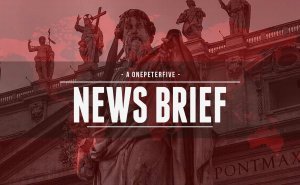
Pope Leo addressed the Jubilee of Eastern Churches yesterday with these words: The address first quoted Francis, but also John Paul II and several times Leo XIII. His Twitter account even posted about it: After this part of the address he rightly condemned the wars which bring great suffering to our Eastern brethren and all peoples. He encouraged the Eastern brethren to remain…
-
Site: RT - News
Kirill Dmitriev has praised the White House for bringing Russians and Ukrainians to the table in Istanbul
US President Donald Trump and his team have “made the impossible possible” by bringing Moscow and Kiev to the cusp of their first direct negotiations since 2022, Russian President Vladimir Putin’s investment envoy, Kirill Dmitriev, has said.
Dmitriev complemented Washington’s mediation efforts ahead of much anticipated talks in Istanbul on Thursday.
The meeting is set to happen “against all odds/fierce resistance,” he said on X, adding that if “not derailed last-minute, this could be a historic step to peace.”
Dmitriev specifically named US Vice President J.D. Vance, Trump’s special envoy Steve Witkoff and Secretary of State Marco Rubio as major contributors to the mediation effort.
READ MORE: Western firms quietly returning to Russia – Putin aide
Putin suggested Thursday as the day direct engagement between Russia and Ukraine could happen in a televised address last Sunday. Moscow has indicated that negotiations could continue from where they left off in 2022, when Kiev pulled out and tried to score a victory on the battlefield with Western military assistance. The U-turn came after then British Prime Minister Boris Johnson told Kiev to discard a draft peace treaty, which had been pre-agreed in Istanbul.
At the moment of writing, there was no certainty that a new round of negotiations would commence as expected. Ukraine’s Vladimir Zelensky, who is currently in the country to meet Turkish President Recep Erdogan, said the Ukrainian government had yet to make a final decision on how to proceed.
Zelensky announced his intention to go to Türkiye in response to Putin’s proposal, claiming that the Russian leader must reciprocate to prove his seriousness. Zelensky and leaders of European NATO nations supporting him have threatened to impose new sanctions on Russia unless Moscow agrees to a 30-day unconditional ceasefire – an idea that Russian officials have called a ruse to give Kiev time to regroup. The initial deadline on Monday has been postponed until the end of the week, pending the outcome of talks.
While Moscow has stated that it will seek a path towards lasting peace in Istanbul, which it says will require addressing the root causes of the conflict, Kiev has been vague about its goals. Some media reports have suggested that the Ukrainian delegation will focus on the proposed ceasefire first. Previously, Kiev insisted that no direct talks could happen without a truce.
-
Site: Novus Motus LiturgicusEven though it was called by a different name, the Ambrosian Rite originally had a feast which was the equivalent of the Byzantine Mid-Pentecost, which I wrote about yesterday, borrowed from that tradition. This article is mostly a translation of notes about it by Nicola de’ Grandi. In the Ambrosian Rite, the Wednesday between the third and fourth weeks after Easter was a feast known as “In Gregory DiPippohttp://www.blogger.com/profile/13295638279418781125noreply@blogger.com0
-
Site: RT - News
MP Riccardo Magi was dragged out of a session for wearing a white sheet with cut-out eyeholes
An Italian opposition MP was dragged out of a parliamentary session on Wednesday for dressing up as a ghost and condemning what he said are attempts to stifle democratic participation.
In a video shared online, Riccardo Magi, a member of the +Europa party, could be seen wearing a white sheet with cut-out eyeholes and the word ‘Referendum’ written on the fabric. During the session, he shouted from his seat to protest what his party claims are government efforts to discourage voter turnout for several national referendums scheduled for next month. The votes are set to cover issues such as Italy’s citizenship requirements for foreigners and repeal certain labor reform provisions.
Magi’s demonstration was cut short after Lorenzo Fontana, the speaker of the Chamber of Deputies, ordered the MP to be escorted out of the session. Parliamentary ushers, together with five security personnel, could then be seen dragging Magi out of the chamber.
Possono trascinare il fantasma del Referendum via dall’aula ma non ci fermeranno nel tentare di informare gli italiani.
— Riccardo Magi (@riccardomagi) May 14, 2025
Chiediamo solo che il Presidente del Consiglio informi i cittadini sul voto referendario. Non le stiamo chiedendo un favore, è un suo preciso dovere.
L’8 e 9… pic.twitter.com/xEKCgpUnsbAfter the incident, Magi uploaded a video of his demonstration on X, writing that “they can drag the ghost of the Referendum away from the chamber but they will not stop us from trying to inform the Italians.”
READ MORE: Media freedom deteriorating in EU – report
“We only ask that the Prime Minister inform citizens about the referendum vote. We are not asking you for a favor, it is your precise duty,” he said, calling on citizens to vote on June 8 and 9 “without fear.”
-
Site: Zero HedgeGermany Wind Power Firms Face Millions In Losses As Wind Speed Drops To 50-Year LowTyler Durden Thu, 05/15/2025 - 07:20
By ReMix News
In many ways, Germany’s wind power revolution has been a success, with wind power serving as the country’s largest source of electricity. However, the current wind lull over the last three months has led to an extreme dip in energy production, which is costing firms millions in losses.
The wind speed average has dropped below less than 5.5 meters per second in the first quarter of 2025, according to German Meteorological Service (DWD). The last time the country saw such low speeds was in 1972 and 1973, and before that, in 1963.
Wind energy producers have been hit hard. For example, PNE, a wind farm operator in Coxhaven, showed revenue dropped to €27.9 million from €31.4 million the previous year, but perhaps more importantly, it went from an operating profit of €1.1 million in the first quarter to a loss of €7.1 million, according to Welt.
The company indicated that there was 31 percent less electricity generated nationwide in the first quarter of the year than in the same period last year, according to data from the German Energy and Water Industry Association (BDEW).
However, it should be noted that April 2024 and 2022 saw much higher wind speeds than previous years, so comparing 2024 to 2025 makes this drop look even more extreme. Experts say there is no evidence of climate change being at work, noting that previous decades have had similar lulls in wind speed.
Germany experienced so-called “dark lulls” over the winter, featuring little sunlight and low wind speed, which led to extremely high prices. Germany imported energy from neighboring countries and turned to conventional power plants in response.
Former Economic Minister Robert Habeck of the Greens had already planned to provide incentives to build 40 large gas-fired plants by 2030 to deal with fluctuations in wind and solar energy. These gas plants had a number of climate protections allegedly built in, such as being able to be switched to hydrogen at some point in the future.
The grid is also at risk due to renewable energy in some instances, especially during holidays when there is less power demand. Solar power cannot be regulated by grid operators, which means that when there is too much electricity and not enough sources that need it, the grid is pushed to its limit. The previous German government, at the urging of grid operators, implemented the PV Peak Act to deal with surplus solar power production.
The average share of solar power energy in 2023 was 31.5 percent, with coal-fired plants in second, at 22.5 percent.
Renewables make up an increasingly large share of Germany’s energy profile, which supporters say reduces reliance on foreign countries such as Russia while also reducing carbon emissions. Critics, on the other hand, say wind power has harmed energy security and also presents a number of environmental risks to wildlife and even forests.
However, it is not just countries like Germany turning to renewables. Conservative governments, including Hungary’s, are also increasingly shifting to wind and especially solar, where it is one of Europe’s leaders.
-
Site: RT - News
Ben Cohen disrupted a Senate hearing, shouting that the US Congress facilitates the delivery of bombs that kill Palestinian children
The millionaire co-founder of the iconic Ben & Jerry’s ice-cream brand, Ben Cohen, was among seven individuals arrested on Wednesday after disrupting a US Senate hearing to protest Washington’s policy on Israel’s military actions in Gaza.
Cohen was detained during testimony by US Health Secretary Robert F. Kennedy Jr. As he was being led away by police, the entrepreneur was heard shouting “Congress kills poor kids in Gaza by buying bombs and pays for it by kicking kids off Medicaid in the US,” and “Congress and the senators need to ease the siege – they need to let food into Gaza!”
The co-founder of Ben & Jerry’s, which has an estimated annual revenue of $300 million, was forcibly removed from the hearing along with six others. They were charged with the misdemeanor offense of “crowding, obstructing, and incommoding” – a law that prohibits demonstrations inside congressional buildings.
Cohen and his Ben & Jerry’s co-founder, Jerry Greenfield, are known for their activism, including criticism of Israel’s actions in Gaza and the occupied West Bank.
https://x.com/YoBenCohen/status/1922760476439515310“I told Congress they’re killing poor kids in Gaza by buying bombs, and they’re paying for it by kicking poor kids off Medicaid in the US. This was the authorities’ response,” Cohen posted on X after his release from custody.
The US is Israel’s largest arms supplier, providing more than two-thirds of the Jewish state’s weapons imports. The US spent $17.9 billion on military aid to Israel between October 2023 and October 2024, according to the Costs of War Project at Brown University.
READ MORE: US speeds up arms supplies to Israel
Since President Donald Trump took office in January, his administration has reportedly approved nearly $12 billion in major military sales to West Jerusalem.
In February, Washington signed off on the sale of over $7.4 billion in bombs, missiles, and related equipment to Israel, which has employed US-made weapons with devastating impact during the conflict in Gaza. The Pentagon announced the additional sale of bombs, demolition kits, and other weaponry to Israel in March worth $3 billion.
Israel launched its military campaign in Gaza following a deadly incursion by Palestinian militant group Hamas on October 7, 2023, which left more than 1,100 people dead and more than 200 taken hostage. The heavy aerial and artillery pounding of the densely populated Palestinian enclave, coupled with an Israeli ground operation, have since claimed the lives of over 60,000 people, with many more injured or missing, Palestinian authorities have estimated.
-
Site: Mises InstituteFollowing World War II, Congress imposed mandates on the Federal Reserve in the areas of employment, inflation, and interest rates. Not surprisingly, the Fed has failed in all three areas. It is time to recognize failure and abolish the Fed altogether.
-
Site: southern orders
Earthly signs of the Kingdom of Heaven after the passion, death and resurrection of Christ the King:
-
Site: Zero HedgeHarvard Tops America's Largest University Endowments (For Now)Tyler Durden Thu, 05/15/2025 - 06:55
University endowments held more than $870 billion in assets last year, largely dominated by America’s elite institutions.
While Harvard, Yale, and Stanford have amassed tens of billions in assets, the median endowment stands at $243 million across 658 institutions.
Overall, endowment assets increased by 4% in 2024 driven by donations and investment returns.
This graphic, via Visual Capitalist's Dorothy Neufeld, shows the largest university endowments in America, based on data from the NACUBO via College Transitions.
Harvard Leads Nationally
As the largest university endowment worldwide, Harvard boasts a number of wealthy donors including Michael Bloomberg and hedge fund billionaire John Paulson.
After the Trump administration froze billions in grants and funding, it raised $1.1 million across more than 4,000 online donations in the first two days after stating it would push back against their demands. Overall, the fund holds $52 billion in assets, as shown in the table below:
As we can see, the University of Texas System is the only public university endowment ranking in the top five.
In fact, UT Austin is among the few universities that has invested in Bitcoin, along with Stanford and Brown. While endowments typically avoid riskier investments, they are increasingly allocating funds into cryptocurrency thanks to regulatory factors.
Overall, a number of elite institutions have the largest endowments nationally, including Stanford (#4) and Princeton (#5).
How Do University Endowments Spend Their Assets?
While university’s hold significant endowment funds, much of the assets are designated for a specific purpose, such as scholarships.
At the same time, these assets are often invested in illiquid assets such as real estate and hedge funds. As a result, it can be damaging to sell these at a loss if universities face a funding shortfall.
Below, we show how $30 billion in endowment funds were spent during fiscal year 2024:
Overall, nearly half of spending went toward student financial aid, with some of the largest endowments such as Stanford and Harvard covering 100% of students financial aid requests.
Academic research was the second-highest category, at 18%, followed by endowed faculty positions, at 11%. Specifically, these positions are funded by endowment donations over a number of years. Finally, facilities operation and management accounted for the smallest share, at 7% overall, covering renovations and building repairs.
To learn more about this topic from a global perspective, check out this graphic on the top universities outside of America.
-
Site: Zero HedgeUK Farmers Fear For Bioethanol Market Following US Trade DealTyler Durden Thu, 05/15/2025 - 06:30
-
A recent trade deal between the UK and the US has led to the removal of tariffs on American bioethanol, which British farmers fear will undermine their domestic market.
-
Concerns exist among beef farmers that the deal will result in increased American beef imports, leading to unfair competition and impacting their livelihoods.
-
The trade agreement has sparked widespread scepticism among British farmers regarding the government’s commitment to protecting their interests and the future of the agricultural sector.
Ministers and commentators heralded the UK’s trade deal with the United States as a political coup that will save thousands of jobs at British automakers. But changes to beef and bioethanol trade rules have left an already bruised agricultural sector fearing the worst, writes Ali Lyon.
When he’s not slavishly editing clips for the hundreds of thousands of people that subscribe to his Youtube channel, Olly Harrison has the not insignificant job of running 1,500 acres of farmland.
But as his impressively regular feed of videos illustrates, tending to that land – and trying to eke out a semblance of profit from it – has become a difficult, bordering on impossible task, as headwind after headwind hit his arable holding near Liverpool.
“It’s been rubbish,” he tells City AM, still dealing with the aftermath of what was England’s driest April on record.
“We’ve had extremes of weather, which has been very wet or – like now – very dry.”
Added to recent years’ inhospitable climes, are the input costs for producing the wheat his family has grown for five generations. They have, he says, remained at the elevated prices sparked by Russia’s invasion of Ukraine. At the same time, the price he is able to secure for his end product has fallen by as much as 40 per cent since those 2022 supply-constraint-induced highs.
But it is another, more recent, external shock that has Harrison especially worried. One that, while niche and esoteric, could kibosh the safety net he and his fellow British arable farmers have traditionally fallen back on when the wholesale wheat price drops too low.
Bioethanol: The little-known safety net of arable farmers
“The bioethanol market in the UK – for wheat – is quite big,” Harrison says.
“It’s basically the floor in the market.”
Opening up the UK and US’s agricultural markets to more trade was a key football in the frenzied negotiations that helped the Starmer administration become the first country in the world to secure a trade deal with America since 2 April’s ‘Liberation Day’.
And to spur the States’ capricious President into bringing down painful tariffs on Britain’s export industries like automakers and plane parts, the government agreed to lower its own levies on a selection of American agriculture products; namely beef and the fuel.
The beef tariffs were reduced only on imports that subscribed to the UK’s world-leading food standards, leading some in the farming community to breathe a partial sigh of relief. But the bioethanol concessions – which saw the UK’s 19 per cent tariff abolished completely – contained no such caveats to protect our sizeable domestic industry. That decision has already sparked warnings from key figures involved in domestic bioethanol production that their sector could be facing extinction.
“Bioethanol, for me, is the watch area,” Tom Bradshaw, president of the National Farmers’ Union (NFU) tells City AM.
“I have been speaking to the bioethanol manufacturing sector… and we think [these changes] probably make it unviable.”
The prognosis from Bradshaw – whose assiduous campaigning around the recent inheritance tax reforms has already made him a regular thorn in the government’s side – was echoed by the UK’s two largest bioethanol producers over the weekend.
The chief executive of London-listed AB Foods’ sugar division, Paul Kenward, and Grand Pearson, the chairman of Ensus, both warned in a joint intervention their “strategically essential sector” was under an “existential threat”.
All of which has left Harrison worried about what it will do to demand for his product. “If they can now bring it [ethanol] in from the States – using wheat that’s grown a lot cheaper than we can because they get a lot more support off their government, using technologies that we can’t, from farms that have got scale that we haven’t – then that’s seriously undermining a sector that’s already on its knees,” he says.
A hollowed out bioethanol sector also poses the risk of some unsavoury knock-on effects for livestock farmers, the very area of agriculture that the government sought to protect during its negotiations.
Because just as Unilever sources its ingredients for Marmite from breweries – and the byproducts produced in the fermenting process – bioethanol producers sell one of their own high-protein outputs as feed for cows.
As Bradshaw summarises: “If they’re not making bioethanol, we won’t get that animal feed.”
Yet more farmer beef
The feed supply issue is just one of several fears that Joe Seels, a Yorkshire-based beef farmer, has for his livelihood as the dust settles on the trade deal.
The NFU’s Bradshaw went to lengths to praise the government for maintaining standards in the face of US pressure. But for Seels, who documented his attendance at the string of protests in London around the changes to inheritance tax on his own Youtube channel, the deal represents yet another example of British agriculture being the fall industry to fix problems elsewhere in the economy.
His primary concern is that there will now be a glut of beef supply in the UK, without the same opportunities to export to the US. Because while the deal ostensibly brings down barriers to trade both ways – both countries agreed to accept 13,000 metric tonnes of beef imports each other each year tariff free – Seels can’t imagine a world in which American food producers buy British.
“I’m really sceptical that it will open up new export avenues,” he says.
“Being American is eating American beef, they won’t accept ours which will be at a premium to [the hormone-aided beef] in their market.”
While the challenging trade environment in the US will persist, British farmers, he adds, will now face stiff competition from the low-cost American beef that will now be available at home.
Consumers and supermarkets are likely to continue to prefer domestically produced beef. Despite other large beef producing nations having access to the UK market, shoppers overwhelmingly prefer meat produced domestically or in Ireland. Senior figures in retail believe that the ubiquity and salience of farm labelling – from the ‘red tractor’ signifier of food standards to the regular sight of union-jack adorned packaging – mean shoppers are unlikely to find American meat in supermarket aisles.
Where Seels and Bradshaw imagine the influx of American beef will be felt, however, is catering and hospitality, where choice is constricted and labelling is less prominent.
“They [the US] have got less red tape, fewer planning restrictions, and their farming operations are just on a huge scale, which all leads to being able to create a product that’s much cheaper,” says Seels.
“We won’t see that on shelves,” he adds, “but where this beef might have a market is food services.”
Ministers have been at pains to trumpet the deal’s positive impact on livestock farmers, many of whom have long feared the spectre of chlorinated chicken and hormone beef being a concession in wider UK-US trade talks. But years of feeling let down by successive governments, mean farmers remain fearful of what the future holds.
“I have no faith whatsoever that the government will protect our interests in future negotiations,” says Harrison.
"They’re just giving us another kick every time, and not realising how vulnerable the farming sector is.”
That scepticism is shared by Seels, who like Harrison is also a popular farming video blogger and has previous in using his channels to vent at political decision making.
“This government has said things to us in the past that it wasn’t going to do then it’s turned around and changed its mind,” he says.
If it does so again, ministers can expect the vitriolic response comprising more than just a few fiercely worded Youtube videos.
-
-
Site: RT - News
President Donald Trump is open to any framework that brings peace between Kiev and Moscow, the secretary of state has said
US President Donald Trump is prepared to accept any mechanism that leads to peace between Russia and Ukraine, according to Secretary of State Marco Rubio. His statement comes as delegations from Kiev and Moscow are expected to meet in Istanbul on Thursday for their first direct talks since 2022.
Speaking at a gathering of NATO foreign ministers in the Turkish resort city of Antalya on Thursday, Rubio said, “We are open to being constructive and helpful in any way we can to end the conflict.”
“We’ll see what happens over the next couple of days, but we want to see progress made in that regard,” Rubio said. “I will say this and I’ll repeat it: there is no military solution to the Russia-Ukraine conflict. This war is going to end not through a military solution but through a diplomatic one.”
Negotiations were proposed last week by Russian President Vladimir Putin, who offered to resume a direct dialogue between Moscow and Kiev without any preconditions to reach a lasting resolution to the conflict.
Ukraine’s Vladimir Zelensky had said he was ready to engage in talks, but insisted on an unconditional 30-day ceasefire first – a demand Moscow has repeatedly rejected. Zelensky also said he would engage in the talks in Istanbul only if Putin attends in person.
Read more Kremlin rules out Putin appearance at Ukraine peace talks
Kremlin rules out Putin appearance at Ukraine peace talks
However, the Russian leader’s proposal was backed by US President Donald Trump, who urged Kiev to “immediately” accept it. Following Trump’s comments, Kiev seemingly shifted its position.
On Wednesday, the Russian president announced that the country’s delegation would be led by presidential aide Vladimir Medinsky, who played the same role during previous negotiations with Kiev in 2022. Deputy Foreign Minister Mikhail Galuzin, Deputy Defense Minister Aleksandr Fomin and the head of Russia’s military intelligence, Igor Kostyukov are also set to participate.
The US president said he could potentially alter ongoing travel plans in the Middle East. “If something happened, I’d go on Friday if it was appropriate,” he told journalists in Qatar on Thursday morning.
Trump reiterated his wish to end the Ukraine conflict and expressed hope “that Russia and Ukraine are able to do something, because it has to stop.”
-
Site: Real Investment Advice
Rising inflation can chip away at the value of your money and investments, making it one of the most persistent threats to long-term wealth. As prices increase and purchasing power declines, investors must be proactive in adjusting their strategies to protect their portfolios.
If you’re looking to safeguard your wealth in a high-inflation environment, now is the time to consider investments that are positioned to outpace inflation and preserve your future financial security.
Understanding Inflation’s Impact on Investments
Inflation decreases the value of money over time, which means the same dollar buys less than it did before. For investors, this erosion affects real returns—the actual buying power of your investment gains after adjusting for inflation.
Traditional low-yield investments like savings accounts and some bonds may no longer keep up with inflation, leading to a net loss in purchasing power. To stay ahead, investors must rethink their approach and pivot toward inflation-resilient strategies.
Inflation-Proof Investment Strategies
Certain asset classes tend to perform better when inflation is high. Diversifying into these areas can help protect your portfolio and maintain its value over time.
Treasury Inflation-Protected Securities (TIPS)
TIPS are U.S. government bonds specifically designed to hedge against inflation. Unlike traditional bonds, the principal of TIPS increases with the Consumer Price Index (CPI). This means your investment grows in step with inflation, offering both income and preservation of purchasing power.
Commodities and Real Assets
Commodities such as gold, oil, and agricultural products often rise in value during inflationary periods. Investing in commodities, either directly or through mutual funds or ETFs, can help balance your portfolio.
Real assets like real estate and infrastructure projects also tend to appreciate with inflation. Real estate investment trusts (REITs) provide a more accessible way to invest in this sector while also offering the potential for income.
Dividend-Paying Stocks
Companies that consistently pay and increase dividends often indicate financial strength and resilience. Dividend-paying stocks can help generate reliable income and may keep pace with or exceed inflation over time.
Sectors such as consumer staples, utilities, and healthcare tend to maintain demand even during economic uncertainty, making them good candidates for inflation-sensitive investing.
Adjusting Asset Allocation in a High-Inflation Market
To stay ahead of inflation, investors should revisit their asset allocation. A portfolio heavily weighted in cash or low-yield bonds could be vulnerable to erosion in purchasing power. Instead, consider:
- Reducing exposure to long-duration bonds
- Increasing allocations to equities with pricing power
- Incorporating inflation-hedged assets like TIPS or commodities
- Maintaining diversification to reduce overall risk
By taking a balanced approach and revisiting your investment mix, you can better align your portfolio with today’s economic realities.
Work With an Advisor to Build Your Strategy
Inflation isn't a temporary inconvenience—it can have long-term effects on your wealth if not properly addressed. That’s why it’s essential to have a strategy tailored to your goals, timeline, and risk tolerance.
RIA Advisors offers personalized guidance to help you develop an inflation-proof investment strategy. We’ll help you adjust your asset allocation, explore inflation-resilient investments, and stay on track—no matter how the market shifts.
Contact RIA Advisors today to schedule your consultation and build a financial plan that adapts and endures.
FAQs
What are the best investments during high inflation?
TIPS, dividend-paying stocks, commodities, and real assets like real estate are generally strong choices in high-inflation periods.
How do dividend stocks help with inflation?
They provide a consistent income stream and may grow over time, helping to offset the eroding effects of inflation on purchasing power.
Should I adjust my portfolio during inflation?
Yes. It’s often wise to reduce low-yield assets and increase holdings in inflation-resistant investments while staying diversified.
Is cash a safe option during inflation?
Cash offers stability, but it typically loses value in real terms during high inflation. Keeping too much in cash can be a long-term risk.
Can a financial advisor help me protect against inflation?
Absolutely. An advisor can help assess your exposure, adjust your strategy, and identify investments that align with your long-term goals.
The post The Best Investment Strategies for a High-Inflation Environment appeared first on RIA.
-
Site: Real Investment Advice
Below our Market Trading Update, we share analysis from the Atlanta Fed showing that housing affordability has been at its worst in the last twenty years. This is unsurprising given that potential homebuyers face the highest mortgage rates in 20+ years. Moreover, they must contend with inflated house prices and little housing supply. The news for potential homebuyers is even grimmer when looking at the graph below, courtesy of the Financial Times. Over the last ten years, the average size of existing and new home sales has shrunk by about 10%. So not only are homebuyers, in aggregate, committing almost half of their income to buy homes, but they are getting 10% less than they would have a few years ago.
So, this begs the question: Why is the average square footage of homes for sale declining?
- Affordability: Given the affordability problem, some homeowners are forced to buy smaller houses to cut costs.
- Developers Face Inflation: New home builders are trying to minimize construction costs to keep prices more affordable. Inflation in construction goods has made this a necessity for lower-income housing buildings.
- Demographics: A growing number of single or childless couples want to buy homes. Further, the outsized baby boomer generation is starting to retire and wants smaller homes.

What To Watch Today
Earnings

Economy

Market Trading Update
Yesterday, we noted that buybacks, negative sentiment, and positioning support the recent market rally. However, with markets back to short-term overbought on both a relative strength and momentum basis, where are your entry points on a pullback? We can use trend, support, and retracement levels to define entry points to add equity exposure. However, these levels can also help us determine when the pullback becomes a failed "bear market" rally and lower lows are likely.
As shown, the market has recovered most of its April losses. While it is not uncommon for a market to bottom and rally immediately back to all-time highs, there is a reasonable expectation that the market will take a "pause" before resuming its push higher. As we have discussed over the past few weeks, the market rally has taken out previous levels of resistance at the 50, 100, and 200 DMA, along with those that previously served as support levels during the decline. Therefore, using that same analysis, any "pause" in the advance should find buyers at the following levels.
- The conjunction of the 100 and 200-DMA was also the top of the initial March rally. If the market holds that level and consolidates to work off the overbought conditions, it would provide a decent launch pad for a move from 5900 to 6000.
- A failure at those levels, which would not be surprising, would find initial support at the 23.6% retracement level, followed immediately by the 20 and 50-DMA just below. It is worth noting that the 20-DMA has crossed above the 50-DMA, providing additional support to the market during any pullback. Notably, any pullback to this level of support should have the markets back to decently oversold levels, providing a good entry point to add exposure to equity risk.
- However, a failure at those levels will suggest that the current rally was indeed a "bear market rally" and a more profound decline is forthcoming. Just below the 50-DMA average are the 50% and 61.8% retracement levels. The market should find buyers at those levels, and we would look for the market to start trying to find a bottom. However, the 78.6% retracement level, which coincides with the mid-April pullback, will likely be the absolute bottom. But once we start delving into these levels, something else has gone wrong, so we will deal with that issue if it presents itself.

While there is little reason to be bearish currently, especially with buybacks in full swing as noted yesterday, that does not mean that the market will not have pullbacks along the way. The only thing we want to be aware of regarding risk management is navigating a pullback that allows us to increase risk, versus understanding when "the best laid plans have gone wrong."
Don't be overly complacent. There is still an elevated level of risk to the market.

The Atlanta Fed Housing Affordability Index
The Atlanta Fed’s Home Ownership Affordability Monitor (HOAM) Index calculates how affordable housing is based on the median-income household trying to purchase a median-priced home. It compares household incomes to the costs of homeownership, including the mortgage payment, taxes, insurance, and private mortgage insurance. To put the number in context, the Atlanta Fed deems that homes, in aggregate, are unaffordable if the total costs exceed 30 percent of median household income. The index is centered around 100. Thus, an index value below 100 is unaffordable. Conversely, values above 100 indicate affordability.
The first graph below shows that the housing affordability index is at its lowest in 25 years. The second graph shows that it currently takes 46% of median income for homebuyers to purchase a median-priced home.


Recent HOAM data signals persistent affordability challenges. As of August 2024, the national index showed a year-over-year affordability decline of 3.6 percent, milder than the 7.5 percent average drop over the prior year, but still reflecting strain from elevated home prices and mortgage rates. The qualifying income to afford a median-priced home reached $119,640, 40.3 percent above the median household income of $85,255, highlighting a significant affordability gap.
The Wealth Effect Is Not Always Virtuous
Bernanke boasted that by fortifying liquidity in the financial markets via QE and lower Fed Funds, the Fed boosted stock returns and thus greased the wheels of the “virtuous circle.”
Since then, periods of easy monetary policy have correlated well with positive stock market returns. While that relationship is noteworthy, we must also consider the other side of the coin. When the Fed is not providing ample liquidity to the financial markets and stock returns are negative, there must be an adverse wealth effect. Simply, the wheels of Bernanke’s virtuous circle get stuck in the mud.
Accordingly, given the recent market volatility and the possibility of an adverse wealth effect, it’s worth quantifying the relationship between stock returns and economic activity.

Tweet of the Day

“Want to achieve better long-term success in managing your portfolio? Here are our 15-trading rules for managing market risks.”
Please subscribe to the daily commentary to receive these updates every morning before the opening bell.
If you found this blog useful, please send it to someone else, share it on social media, or contact us to set up a meeting.
The post Homebuyers Are Paying More For Less appeared first on RIA.
-
Site: Crisis Magazine

In a recent post on her Substack newsletter, Sarah Cain made a statement that, although predictable and already common in such difficult times, always gives us pause for thought: “Pope Francis was the biggest impediment to my conversion. I know that I’m not alone in that.” Clearly, Cain is not the only one who has had to overcome such a difficulty. Terrible problems and doubts have confronted all…
-
Site: Crisis Magazine

In another example of the culture co-opting and distorting something holy, DEI has become a popular acronym for Diversity, Equity, and Inclusion. And it’s no coincidence when we say this movement is not of God, for the Latin Dei means just that: of God. Even if the people who coined the acronym and push the agenda it stands for did not intend to co-opt the name of God, Satan is surely at work and…
-
Site: AsiaNews.itThe breakdown in relations with Europe was portrayed by Russian propaganda as a bright new horizon for the Eurasian space. But sanctions have enabled Kazakhstan, Kyrgyzstan and Uzbekistan to grow in their role as intermediaries in trade with third countries. And today, many migrants are looking more to the West than to Moscow.
-
Site: AsiaNews.itToday's news: Dozens dead after two days of Israeli bombing in the Gaza Strip. Indonesia plans to send 'unruly adults' for military training. The Philippines and Germany sign a defence cooperation agreement. Military operation in the Indian state of Manipur against suspected militants from Myanmar. APEC warns of the risks tariffs pose to economic growth.
-
Site: Mises InstituteIsn’t it funny how, with the possible exception of Vietnam, all of America’s wars have been justified and have been right and good? What are the odds?
-
Site: Mises InstituteAll potentially unpopular cuts will hit only after 2026 or 2028. This is proof Trump was never serious about any real spending cuts. These cuts will never actually happen.
-
Site: RT - News
The US president could change his travel plans on Friday ‘if something happened’
US President Donald Trump is considering a visit to Türkiye on Friday, as Ukraine and Russia are set to resume direct peace negotiations for the first time since 2022.
The US leader, who seeks to facilitate a truce in the Ukraine conflict, said he could alter travel arrangements amid his ongoing Middle East trip. “If something happened, I’d go on Friday if it was appropriate,” he told journalists in Qatar on Thursday morning.
Trump reiterated his wish to end the Ukraine conflict and expressed hope “that Russia and Ukraine are able to do something, because it has to stop.”
Russian President Vladimir Putin proposed last week to restart negotiations that Kiev aborted in April 2022 to pursue a military victory. Ukraine’s Vladimir Zelensky responded by declaring that he will personally go to Türkiye and expects Putin to do the same to prove his intentions.
Read more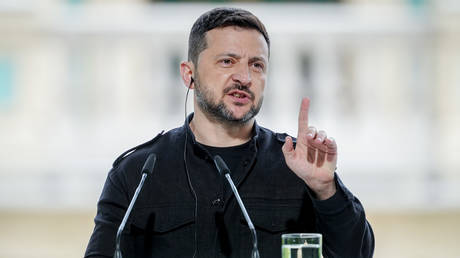 Zelensky claims ban on Russia talks doesn’t apply to him
Zelensky claims ban on Russia talks doesn’t apply to him
Moscow listed the members of its delegation late on Wednesday. It is being led by presidential aide Vladimir Medinsky, who played the role during previous negotiations with Kiev.
When asked by the media whether he was disappointed by the composition, Trump said he didn’t expect Putin to travel to Türkiye as he himself hadn’t made similar public arrangements.
“I said, I don't think he's going to go if I don't go. And that's turned out to be right,” he explained, adding that he has confidence in members of his administration, including Secretary of State Marco Rubio, who would travel to Istanbul on Friday alongside Trump’s special envoy, Steve Witkoff.
The list of Russian officials sent to Istanbul also includes Deputy Foreign Minister Mikhail Galuzin, Deputy Defense Minister Aleksandr Fomin, and Deputy Head of the Russian General Staff Igor Kostyukov, the head of the country's military intelligence.
READ MORE: Trump predicts ‘good news’ from Russia-Ukraine talks
In 2022, Medinsky’s team negotiated a potential peace deal. Its terms offered Kiev Russian security guarantees in exchange for neutrality and restrictions on its standing army. David Arakhamia, who headed the Ukrainian delegation, later revealed following the pre-approval of the draft treaty that then-British Prime Minister Boris Johnson had told Kiev to “just fight,” leading to the continuation of hostilities.
-
Site: Mundabor's blogOne of the most famous poems of the great, great Giacomo Leopardi deals with the sense of elation and serenity that comes after the storm has passed. With consummated art, and with an exquisite sensitivity the more remarkable because of his young age, Leopardi paints a familiar, but extremely vivid picture of village life and […]
-
Site: Mises InstitutePolitical Scientist Joseph Solis-Mullen joins Ryan McMaken to review Ralph Raico's newly published lectures on politics in the West. We recommend this book for all who want a pro-freedom history of political thought.
-
Site: Mises Institute
-
Site: Zero HedgeNetanyahu Charges Macron With 'Despicable' Support For Hamas As Spat DeepensTyler Durden Thu, 05/15/2025 - 02:45
A new Gaza-related spat is now raging between the leaders of France and Israel, amid new reports that famine is hitting the Palestinian population, which is said to be impacting 500,000 people.
French President Emmanuel Macron has called the military policies of Israeli Prime Minister Benjamin Netanyahu "shameful" and "unacceptable" in a fresh interview with a national broadcaster.
"What the government of Benjamin Netanyahu is doing is unacceptable," Macron began in a Gaza segment of the interview. "There is no water, no medicine, the wounded cannot get out, the doctors cannot get in. What he is doing is shameful," he continued.
 Via Associated Press
Via Associated Press
He then interestingly appeared to leverage recent reports saying that Trump-Netanyahu relations have reached a low point, and that the White House is fed up with Bib.
"We need the United States. President Trump has the levers. I have had tough words with Prime Minister Netanyahu. I got angry, but they [Israel] don't depend on us, they depend on American weapons," Macron said.
Macron here seemed to be calling on Washington to essentially put the Netanyahu government in its place, as Trump has sidelined Tel Aviv on everything from the Houthi ceasefire to gaining the freedom of Israeli-American hostage Edan Alexander. And more:
"My job is to do everything I can to make it stop," Macron said, adding that the possibility of revisiting the EU trade cooperation agreements with Israel is on the table.
Never one to back down from a diplomatic war of words, Netanyahu hit back on Wednesday, going so far as to say that Macron stands with Hamas.
"Macron has once again chosen to stand with a murderous terrorist organization and echo its despicable propaganda, accusing Israel of blood libels," a statement from the Israeli prime minister's office said.
"Instead of supporting the Western democratic camp fighting the Islamist terrorist organizations and calling for the release of the hostages, Macron is once again demanding that Israel surrender and reward terrorism," the blistering Netanyahu statement added.
The NY Times has issued an alarming report this week which said "Some Israeli military officials have privately concluded that Palestinians in Gaza face widespread starvation unless aid deliveries are restored within weeks, according to three Israeli defense officials familiar with conditions in the enclave."
The report continued by saying "Israeli military officers who monitor humanitarian conditions in Gaza have warned their commanders in recent days that unless the blockade is lifted quickly, many areas of the enclave will likely run out of enough food to meet minimum daily nutritional needs, according to the defense officials."
Shocking statement from French President Macron: Netanyahu’s blocking of aid to Gaza is shameful. • What is happening in Gaza is an unacceptable and horrific humanitarian tragedy that must be stopped. • Pressure must be put on Israel pic.twitter.com/D4efgGNWAu
— Furkan Gözükara (@GozukaraFurkan) May 13, 2025Currently a US-backed aid plan is being worked on, which is said to be 'independent' amid accusations that Hamas has been stealing and reselling inbound aid. Others have accused Israel of blocking it, in pursuit of a total siege policy.
What's clear is that Netanyahu is increasingly in the political hotseat not just at home, but on the international stage as well - where his closest ally the United States has appeared to grow somewhat cool on the previously enthusiastic support and relationship.
-
Site: Zero HedgeYemen Taught Trump Some Lessons That He'd Do Well To Apply Towards UkraineTyler Durden Thu, 05/15/2025 - 02:00
Authored by Andrew Korybko via substack,
The lessons from Trump’s Yemeni debacle could inform his future decisions on Ukraine...
Five New York Times (NYT) journalists collaborated to produce a detailed report earlier this week about “Why Trump Suddenly Declared Victory Over the Houthi Militia”. It’s worth reading in full if time permits, but the present piece will summarize and analyze its findings. To begin with, CENTCOM chief General Michael Kurilla proposed an eight- to -10-month campaign for degrading the Houthis’ air defenses before carrying out Israeli-like targeted assassinations, but Trump decided on 30 days instead. That’s important.
The US’ top regional military official already knew how numerous the Houthis’ air defenses were and how long it would take to seriously damage them, which shows that the Pentagon already considered Houthi-controlled North Yemen to be a regional power, while Trump wanted to avoid a protracted war. It’s little wonder then that the US failed to establish air superiority during the first month, which is why it lost several MQ-9 Reaper drones by then and exposed one of its aircraft carriers to continued threats.
The $1 billion in munitions that were expended during that period widened preexisting divisions within the administration over whether this bombing campaign was worth the mounting costs. New Chairman of the Joint Chiefs of Staff General John Caine was concerned that this could drain resources away from the Asia-Pacific. Seeing as how the Trump Administration’s grand strategic goal is to “Pivot (back) to Asia” for more muscularly containing China, this viewpoint was likely decisive in Trump’s final calculations.
Oman reportedly provided the “perfect offramp” for him by proposing to his envoy Steve Witkoff, who was visiting them as part of the US’ nuclear talks with Iran, that the US could stop bombing the Houthis while they’ll stop targeting American ships but not ships that they deem helpful to Israel. This draws attention to that country’s outsized diplomatic role in regional affairs, but it also shows that the US was hitherto unsure of how to end its campaign in a face-saving way despite already realizing that it failed.
Two pathways were considered:
-
ramping up operations for another month, carrying out a “freedom of navigation” exercise, and declaring victory if the Houthis didn’t fire on them;
-
or continuing the campaign while strengthening the capacity of local Yemeni allies to start another offensive in the North.
Both were reportedly scrapped in favor of Trump’s sudden victory announcement after another US jet fell off of an aircraft carrier, a US attack killed dozens of migrants in Yemen, and the Houthis hit Ben Gurion Airport.
Five conclusions can be drawn from the NYT’s report.
For starters, Houthi-controlled North Yemen is already a regional power and has been so for some time, the status of which they achieved despite the Gulf coalition’s previous years-long bombing campaign and ongoing partial blockade. This impressive feat speaks to their resilience and the effectiveness of the strategies that they’ve implemented. North Yemen’s mountainous geography indisputably played a role in this, but it wasn’t the sole factor.
The second conclusion is that Trump’s decision to authorize a very time-limited bombing campaign was therefore doomed from the get-go. He either wasn’t fully informed of the fact that North Yemen had already become a regional power, perhaps due to military officials self-censoring for fear of getting fired if they upset him, or he had ulterior motives in having the US bomb them for only a brief time. In any case, there was no way that the Houthis were going to be destroyed in just several months’ time.
Optics are important for every administration, and Trump’s second one prioritizes them more than any other in recent memory, yet the third conclusion is that he still beat a hasty retreat once the strategic risks started spiraling and the costs began piling up instead of doubling down in defiance. This shows that ego- and legacy-related interests don’t always determine his policy formulations. Its relevance is that no one can therefore say for sure that he won’t cut and run from Ukraine if peace talks collapse.
Building upon the above, the Trump Administration’s acceptance of Oman’s unsolicited proposal that led to the “perfect offramp” shows that it’ll listen to proposals from friendly countries for defusing conflicts in which the US has become embroiled, which could apply towards Ukraine. The three Gulf states that Trump is visiting this week have all played roles in either hosting talks or facilitating exchanges between Russia and Ukraine so it’s possible that they’ll share some peace proposals for breaking the impasse.
And finally, the China factor looms over everything that the US does nowadays, ergo one of the reported reasons why Trump suddenly ended his unsuccessful bombing campaign against the Houthis after being informed by his top brass that it was wasting valuable munitions that would be better sent to Asia. Likewise, Trump might be convinced by similar arguments with regard to the strategic costs of defiantly doubling down in support of Ukraine if peace talks collapse, which the Gulf states might convey to him.
Connecting the lessons from Trump’s Yemeni debacle with his ongoing efforts to end the Ukrainian Conflict, it’s possible that he might at first instinctively double down in support of Ukraine if peace talks collapse only to soon thereafter be dissuaded by his top brass and/or friendly countries. Of course, it would be best for him to simply cut his country’s losses now instead of continuing to add to them, but his increasingly emotional posts about Putin hint that he might blame him and overreact if talks collapse.
It's therefore more important than ever that peace-loving countries which have influence with the US immediately share whatever creative diplomatic proposals they might have in mind for breaking the impasse between Russia and Ukraine.
Trump is creeping towards a Yemeni-like debacle in Ukraine, albeit one with potentially nuclear stakes given Russia’s strategic arsenal, but there’s still time to avert it if the “perfect offramp” appears and he’s convinced that accepting it would assist his “Pivot (back) to Asia”.
-
-
Site: Real Jew News
Won’t Back Down
May 14 2025___________________________________
More Vids!
+BN Vids Archive! HERE!
___________________________________
Support The Brother Nathanael Foundation!
Br Nathanael Fnd Is Tax Exempt/EIN 27-2983459

Or Send Your Contribution To:
The Brother Nathanael Foundation, POB 547, Priest River, ID 83856
E-mail: brothernathanaelfoundation([at])yahoo[dot]com
Scroll Down For Comments
-
Site: The Unz ReviewWhat passes for International Justice is a sham, propped up by a vocabulary stripped of its original meaning. If ever there was miscarriage of justice, it was the so-called Nuremberg Tribunal. Though it was essentially a kangaroo court, a shameful charade no different from the sessions held by Judge Roy Bean in 19th-century Texas, it...
-
Site: RT - News
The Islamic Republic has reportedly proposed an alternative to Trump’s demand that it halt uranium enrichment
Iran has proposed setting up a joint nuclear enrichment venture with Arab countries and US investment, The New York Times reported on Tuesday, citing four Iranian officials familiar with the matter.
The plan, reportedly presented by Iranian Foreign Minister Abbas Araghchi during a meeting with American envoy Steve Witkoff in Oman on Sunday, was intended as an alternative to US President Donald Trump’s demand that Tehran completely dismantle its nuclear facilities.
A spokesman for Witkoff, Eddie Vasquez, denied the report, telling the NYT that a joint venture “was never floated or discussed.” The US and Iran have had no formal diplomatic relations since 1980.
Iranian President Masoud Pezeshkian reaffirmed this week that demands for a complete shutdown of the country’s nuclear program were “unacceptable.”
“From our perspective, (uranium) enrichment is something that absolutely must continue, and there’s no room for compromise about that,” Araghchi said earlier this month.
Read more Trump issues nuclear deal threat to Iran
Trump issues nuclear deal threat to Iran
Trump withdrew the US from the 2015 UN-backed nuclear deal during his first term in office, accusing the Islamic Republic of secretly violating the agreement. Tehran has denied any wrongdoing but has since rolled back its own commitments and increased its stockpile of enriched uranium.
Although both sides described the four rounds of Omani-mediated talks as a positive step, tensions remain as the US and Iran continue to clash over the war in Gaza, as well as attacks on international shipping and on Israel by Yemen’s Houthis.
During his Middle East tour on Tuesday, Trump called Iran the “most destructive force” in the region and insisted that it must never be allowed to obtain nuclear weapons.
-
Site: The Unz ReviewIntroductory Note I recently read an old pamphlet titled Facts Are Facts by Benjamin Freedman. I felt intrigued enough to research about the author and found a trove of fascinating history. I wrote about one of the Jew practices he discussed to explain Israeli behavior in Gaza “ceasefire” – the Kol Nidre. The pamphlet itself...
-
Site: AntiWar.comOn May 11, Russian President Vladimir Putin offered to restart direct negotiations with Ukraine in Istanbul. Reuters responded by reminding its readers what happened in the first round of Istanbul talks in the first weeks of the war. The article, entitled “What happened the last time Russia and Ukraine held peace talks?” is a tour … Continue reading "Western Media Continues to Lie About the Ukraine War"
-
Site: AntiWar.comAmong the lesser-known holes in the Constitution cut by the Patriot Act of 2001 was the destruction of the “wall” between federal law enforcement and federal spies. The wall was erected in the Foreign Intelligence Surveillance Act of 1978, which statutorily limited all federal domestic spying to that which was authorized by the Foreign Intelligence … Continue reading "Holes in the Constitution"
-
Site: non veni pacem

-
Site: Zero HedgeAdapt Or Die: Redefining Wargaming For The Age Of Algorithmic WarfareTyler Durden Wed, 05/14/2025 - 23:25
Authored by S.L. Nelson via RealClearWire (emphasis ours),
Commentary
“Adapt or die.” This isn’t just a cliché; it’s a fundamental truth of human survival. Security—the psychological need for stability and protection—is second only to food and water in Maslow’s hierarchy. War directly threatens this security, so understanding war is essential for preserving peace.
One of the oldest tools for grasping the nature of war is wargaming. It is, in essence, a rehearsal—an intellectual simulation that helps leaders make sense of complex, high-stakes decisions before lives and national resources are on the line. But while its utility has persisted, its form has not evolved fast enough to meet the demands of the modern battlefield.
The Problem With Today’s Wargaming
Wargaming is indispensable, but too often, it’s outdated, misused, or misunderstood. In some defense circles, it functions as little more than a stage for confirmation bias, where senior leaders seek validation for preconceived notions rather than insight into novel threats. Worse, wargames frequently remain trapped in analog formats: players huddle around maps, move tokens, make subjective choices, and imagine the rest.
This traditional model assumes that human decisions lie at the heart of conflict. That remains true. But the battlefield is rapidly changing—and the human element is no longer acting alone. As militaries increasingly rely on uncrewed systems, autonomous platforms, and AI-driven operations, our method of simulating war must evolve accordingly.
To prepare for war in 2030, NATO and its allies cannot afford to rely on wargaming methods from 1980. The urgency of modernizing wargaming is not a choice but a necessity for our collective security.
The Rise of Algorithmic Warfare
Consider this: some forecasts suggest that by the 2030s, one-third of militaries could consist of robotic systems. In Ukraine, drone production is trending toward over 2.5 million units annually. This isn’t speculation—it’s already reshaping how war is fought.
In such a world, the idea of a wargame that exclusively simulates human decision-making is dangerously incomplete. Swarms of autonomous drones executing algorithm-driven tactics change not only the character of war but also the speed, scale, and unpredictability of combat. Abstracting these developments away misses the point entirely. A game without machines is a game divorced from reality.
Critically, decision-making itself is changing. While senior leaders continue to anchor their intuition in past experiences, research shows that overconfidence increases in situations involving more chance and ambiguity. Gut instinct, seasoned though it may be, will not suffice when confronted with system-level interactions between thousands of autonomous platforms and sensors.
Technology as a Catalyst, Not a Crutch
The tools to modernize wargaming already exist. Digital environments can now simulate everything from force placement to logistics flows to legal compliance, with users interacting via natural language, voice, or keyboard. This technological advancement offers a beacon of hope for the future of wargaming, allowing commanders to stress-test strategies in real time and track every decision across a replicable digital thread.
This is not science fiction. It is an underused science fact.
Yet many in the defense establishment cling to narrow definitions of wargaming. A leading DoD-affiliated practitioner recently declared, “If the players or sponsors are better equipped at the end of the wargame to do the things they need to do, then there is value. Nothing else matters.” Another dismissed the importance of outcomes altogether, stating that “wargames are about ideas, not facts.”
That’s a dangerous mindset. Strategy may be rooted in ideas, but execution lives in facts. As Churchill famously warned, “However beautiful the strategy, you should occasionally look at the results.”
Toward a New Definition of Wargaming
Commanders’ expectations have evolved, even if the tools haven’t. In 1945, General Eisenhower might have asked his staff for a logistics overlay of the European theater—delivered with pen, paper, and pins. In 2025, General Cavoli might make the same request—but with the expectation of a digital interface offering dynamic updates, AI-enhanced forecasting, and real-time operational feedback.
Unfortunately, EUCOM and NATO commanders still rely too heavily on analog tools. What they need are decision-support systems embedded in the planning process—not adjuncts or afterthoughts.
This calls for a redefinition of wargaming.
A New Definition
Wargaming must be understood not as a parlor game of human strategy but as a rigorous, replicable method of exploring conflict at the strategic, operational, and tactical levels. This includes human decisions and system-level interactions conducted in a synthetic digital environment.
A proposed new definition: “Wargames represent human actions and system-level interactions of conflict or competition in a synthetic environment from the strategic to the tactical level.”
This definition bridges the gap between cognition and computation, people and platforms, gut instinct and algorithmic feedback. It accounts for the growing role of autonomy and artificial intelligence without excluding the indispensable human element.
The Stakes
Wargames must evolve not only because they can but because they must. Definitions matter. The current models fall short of providing leaders with the clarity they need to design force structures that are effective, affordable, and aligned with future threats.
Failure to modernize wargaming risks misinforming critical decisions, wasting resources, and, worst of all, misjudging the very nature of the next fight. The stakes are high, and the battlefield of 2030 will not wait for the analog mind to catch up.
To prepare, we must simulate what war has been and what war is becoming.
-
Site: RT - News
Boris Pistorius says the Bundeswehr needs to boost enlistment amid tensions with Russia
Germany may be forced to revive conscription if not enough people join the army voluntarily, Defense Minister Boris Pistorius has said.
Berlin abolished conscription in 2011 but has recently considered bringing it back, citing “threats” from Russia. According to the broadcaster N-tv, the Social Democrats and Chancellor Friedrich Merz’s Christian Democrats agreed in their coalition deal to introduce the so-called “Swedish model,” which combines selective mandatory and voluntary service.
“We have agreed that we will initially rely on voluntarism – a service that is initially voluntary and intended to encourage young people to serve their country,” Pistorius said in an address to the Bundestag on Wednesday.
“And I say this quite deliberately and honestly: the emphasis is also on ‘initially,’ in case we cannot recruit enough volunteers,” he added.
“In the medium and long term, we will strengthen personnel levels to ensure that the Bundeswehr is sustainably positioned for both homeland security and alliance defense,” the minister said.
Read more Berlin refuses to discuss missile deliveries to Kiev
Berlin refuses to discuss missile deliveries to Kiev
According to Pistorius, applications for military service increased by more than 20% in the first quarter of 2025. Germany plans to raise the number of active soldiers from 180,000 to over 200,000 by 2031.
Enlistment had previously dropped by 7% in 2023, as the Bundeswehr struggled to attract younger recruits, prompting some politicians to describe the recruitment goals as unrealistic.
Although Germany has supplied Ukraine with heavy weapons, including Leopard 2 tanks, Berlin denies that the country is directly involved in the conflict with Russia. Carsten Breuer, Germany’s top general, told Deutsche Welle in March that the country was living in a “grey zone” between full-scale war and complete peace.
During a visit to Lithuania in January, Pistorius claimed that Russia could prepare its army for a “theoretical attack” on NATO in 2029 or 2030.
Moscow has denied any plans to attack NATO member states and accused Berlin of dangerous escalation after Merz voiced support for supplying Kiev with Taurus long-range cruise missiles. Russia argued that the shipment of such sophisticated weapons would make Germany a de facto direct participant in the conflict.
-
Site: Zero HedgeThe Pandemic Agreement: Surveillance, 'One Health', & A New Industry Of Government GriftTyler Durden Wed, 05/14/2025 - 22:35
After three years of negotiation, the delegates of the Intergovernmental Negotiating Body (INB) agreed on the text of the Pandemic Agreement, which now goes for vote at the 78th World Health Assembly (WHA) at the end of May 2025. This text comes after the negotiations were extended for an additional year due to ongoing disagreements about intellectual property and technology transfers (Article 11), access to ‘pandemic-related health products’ (Article 12), and One Health.
After extending the negotiations into a series of last-minute 24-hour sessions in April 2025, a draft was ‘greenlined’ with many countries suggesting that they had gone as far as they could via negotiation, and it was now time to bring it to vote.
There are several interesting elements within the new draft of the Pandemic Agreement. For example, the Pandemic Agreement foresees ‘participating manufacturers’ (yet to be determined) to make 20% of their related pharmaceutical production available to the WHO, half as a donation, and half at ‘affordable prices’ (also to be determined). The expectation is that the WHO and other international partners will pool these and other resources for distribution (in an improved COVAX-like mechanism yet to be determined). In addition, a still relatively undefined ‘Coordinating Financial Mechanism’ (CFM) will be established to support the implementation of both the Pandemic Agreement and the amended International Health Regulations (IHRs), as well as to disburse surge funding to developing countries in the event of a pandemic.
These commitments build on the IHR amendments that come into force in September 2025, which authorise the WHO Director-General to declare a ‘Pandemic Emergency.’ This represents an escalation of the Public Health Emergency of International Concern (PHEIC), with a ‘Pandemic Emergency’ now representing ‘the highest level of alarm,’ which is meant to trigger a host of national and international responses. The PHEIC has been declared eight times since 2005, including for the ongoing Mpox outbreak in Central Africa, and there remains ambiguity about whether an outbreak like Mpox would now also qualify as a Pandemic Emergency. The Pandemic Agreement also now defines the first somewhat tangible effects of declaring a Pandemic Emergency, although these triggering effects are currently most clear regarding the mobilization of ‘pandemic-relevant health products.’
In general, the text reads as one might expect when diplomats from almost 200 countries spent years negotiating and scrutinising every sentence. Although the United States and Argentina withdrew from these negotiations earlier this year, the document still had to navigate the manifold and often conflicting interests of delegates from Russia and Ukraine, Iran and Israel, India and Pakistan; not to mention members of the Africa Group who largely saw the Pandemic Agreement as a raw deal for Africa (see below). The result is therefore 30 pages full of vague declarations of intent, often qualified by references to the preservation of national sovereignty in an attempt to neutralize opposition. As it stands, the ‘Agreement’ looks primarily of symbolic importance, since a failure to reach an agreement would have been embarrassing for everyone involved.
Yet, it would be churlish not to understand that the Pandemic Agreement consolidates ‘pandemic prevention, preparedness, and response’ as a definitive ‘space’ of global political action, for the purpose of which numerous new institutions and funding streams have already been created. Its potential passage into international law is unusual in global health and represents only the second time such a global health covenant has been created (the WHO Framework Convention on Tobacco Control being the first), with the potential to mobilize substantial resources and policies.
For example, according to estimates by the Institute for Health Metrics and Evaluation (IHME), expenditure on preparing for future pandemics had already more than quadrupled between 2009 and 2019 before the Covid-19 pandemic unmistakably moved the topic into international ‘high politics.’ In the Agreement, governments pledge to ‘maintain or increase’ this funding for pandemic prevention, preparedness, and response and to support mechanisms for its execution. As reported elsewhere by REPPARE, the requested funds for pandemic preparedness are $31.1 billion a year (for comparison, about 8 times global expenditure on malaria), of which $26.4 billion must come from low-and middle-income countries (LMICs), while $10.5 billion in new overseas development assistance (ODA) would need to be raised. Presumably, the WHO’s preferred mechanism for the distribution of this ODA is via the yet-to-be-defined CFM.
Vaccine Equity
The declared guiding principle of the Pandemic Agreement is ‘equity.’ The focus on ‘equity’ is driven largely by the WHO and associated philanthropists, NGOs, scientific advisers, and several LMICs (particularly in Africa), who view a lack of equity, primarily ‘vaccine equity,’ as the main failure of the Covid response. Representatives of poorer countries, but also important donors, have criticised the inequitable access to vaccines against SARS-CoV-2 as a key failure of the Covid response and the reason for increased Covid mortality. This inequitable access has been labelled ‘vaccine nationalism,’ which refers to the stockpiling of Covid vaccines in high-income countries (HICs) during the pandemic, limiting availability to vaccines by LMICs. The World Economic Forum, for example, claims that a fairer distribution of vaccines would have saved over a million lives.
While enough Covid vaccine doses were ordered in Europe to immunise the entire population from infants to the elderly more than three times over, and are now being destroyed, many African countries were denied access. In fact, developing countries only received large quantities of coronavirus vaccines months after richer countries had been ‘fully vaccinated.’ Even after vaccination had been universally available in most HIC countries by summer 2021, under 2% in low-income countries had been vaccinated, many of them with Chinese vaccines that Western countries deemed inferior and thus not qualifying for travel clearance.
The proponents of the Pandemic Agreement do not question the success of universal vaccination despite its limited and rapidly declining protective effect, nor the numerous reported adverse effects. But even if we assume that coronavirus vaccines are safe and effective, global comparisons of vaccination rates remain nonsensical. In HICs, most Covid-19 deaths occurred in people over 80, suggesting the need for context-specific interventions in the case of the most vulnerable.
In most low-income countries (LICs), this risk group comprises only a tiny fraction of the population. For example, the average age in Africa is 19, presenting an entirely different pandemic risk and response profile. In addition, a meta-analysis of blood tests by Bergeri et al. suggests that by mid-2021 most Africans had already had post-infection immunity to SARS-CoV-2. Yet, despite these variables, the manufacturers of the vaccines were encouraged to mass produce vaccines for global rollout, were given emergency authorisation, were released from liability, cashed in on advanced purchasing commitments, and were able to make record profits at the expense of taxpayers.
As reported elsewhere, committing large resources to pandemic preparedness, particularly expensive surveillance, diagnostic, R&D, and the manufacturing of biomedical countermeasures, threatens to produce high opportunity costs since many LMICs must confront other more pressing and destructive disease burdens. This was at least implicitly recognised by many African countries during the Pandemic Agreement negotiations. Many resisted the inclusion of One Health into the Agreement, arguing that it was unaffordable and not a priority within their national strategic health plans.
To paraphrase an African delegate on the INB, ‘We have difficulty doing coordinated surveillance within the health sector, let alone integrated surveillance across sectors.’ This concern not only suggests the need for more locally owned strategies to assure the efficient use of scarce resources, but also the need for strategies that better capture contextualised need to deliver greater effectiveness and true health equity, not just ‘product equity.’
Yet, even if product equity is a desired and justified outcome in particular cases, there is nothing in the Pandemic Agreement that guarantees this, since, in practice,e poor countries without their own production capacities will always be last in line. Although the ‘pathogen access and benefit system’ (PABS) in Article 12 of the Pandemic Agreement seeks to improve product equity, it is reasonable to expect wealthy countries to meet their own demand before making larger quantities available to LICs or the WHO for distribution (leaving it reliant on donations – which proved problematic during COVAX). As a result, it is hard to see what the Pandemic Agreement has improved in this regard, other than the codification of extremely loose normative commitments aiming to improve equitable access to pandemic products – an area on which countries would already broadly agree.
The Pandemic Agreement also calls for more transparency for contracts between countries and manufacturers. This measure is seen as a mechanism that can expose rampant vaccine nationalism and profiteering, albeit only ‘as appropriate’ and ‘in accordance with national regulations.’ Thus, it is questionable whether such flimsy wording would have stopped EU Commission President Ursula von der Leyen from fixing billion-dollar deals with the Pfizer CEO through undisclosed text messaging nor stopped other countries from engaging in their own bilateral pre-purchasing and stockpiling activities.
Of course, LMIC negotiators in the INB were aware of all this, which is why the fault line in the Pandemic Agreement negotiations mainly centred on issues of intellectual property and technology transfer. In essence, developing countries do not want to rely on handouts and want to produce vaccines and therapeutics themselves without having to pay expensive licensing fees to the pharmaceutical giants of the North. In contrast, the North has been steadfast in their commitments to intellectual property protections as outlined in TRIPS and TRIPS-Plus, seeing these legal mechanisms as important protections for their pharmaceutical industries.
As a ‘compromise,’ the Pandemic Agreement contains provisions for ‘geographically diversified local production’ of pandemic products and closer international cooperation in research and development, with simplified licensing procedures intended to ensure technology transfer. However, the wording within the Pandemic Agreement is nonspecific and the EU insisted on adding last-minute footnotes to the technology transfer provision to ensure they only take effect ‘as mutually agreed.’ Thus, the Pandemic Agreement looks like the solidification of business as usual.
Surveillance and One Health
Whereas a lack of ‘equity’ is understood by advocates of the Pandemic Agreement as the main failure of the Covid response, a ‘failure of preparedness’ is also seen as allowing the emergence and subsequent global spread of the novel coronavirus in the first place. The goal of eliminating the ‘existential threat’ of emerging infectious diseases (EIDs) is dominant within the policy lexicon, endorsed by the G20 High Level Independent Panel, the World Bank, the WHO, The Elders’ Proposal for Action, and the Global Preparedness Monitoring Board. As we have argued elsewhere, these assessments are largely based on weak evidence, problematic methodologies, the use of political eminence over expertise, and simplified modelling, yet they remained unquestionable mainstays within INB negotiations.
In response to future zoonoses, the Pandemic Agreement calls for a ‘One Health’ approach. In principle, One Health reflects the self-evident fact that human, animal, and environmental health are closely connected. Yet, in practice, One Health requires the targeted monitoring of soil, water, domestic animals, and farm animals with the view to identifying possible spillover to humans. As highlighted above, implementing One Health necessitates integrated systems across sectors with sophisticated laboratory capacities, processes, information systems, and trained personnel. As a result, the costs of implementing One Health are estimated by the World Bank to be approximately $11 billion a year, which would be in addition to the $31.1 billion currently estimated as required to finance the IHRs and Pandemic Agreement.
With more laboratories looking for pathogens and their mutations, it is guaranteed that more will be found. Given the current practice of over-securitized knee-jerk risk assessments, it is foreseeable that more discoveries will be deemed ‘high risk,’ even though humans have coexisted with many of these pathogens without major incident for centuries, and even though the risk of geographical spread is low (e.g., reactions to Mpox). The logic of the Pandemic Agreement is that, based on genomic advancements, ‘pandemic-related health products’ can then be quickly developed and distributed via the ‘WHO Pathogen Access and Benefit-Sharing System’ (PABS).
This is disquieting for at least three reasons. First, large resources will be poured into responding to these low-burden potential risks while everyday killers like malaria will continue to receive an underwhelming response. Second, this aspect of the Pandemic Agreement will undoubtedly engross under its own momentum, where new perceptions of threat legitimate ever-more surveillance, which will uncover even more potential threats in a self-perpetuating regress of securitization and over-biomedicalization. Lastly, nowhere in the Pandemic Agreement is there any mention of the fact that dangerous gain-of-function research will continue to be conducted to develop the ‘pandemic benefits’ expected under PABS, although biosafety and biosecurity obligations are mentioned in passing.
This suggests that the risk assessments associated with the Pandemic Agreement are singularly focused on natural zoonosis spillover events, ignoring an area of risk that may have actually been responsible for the worst pandemic in the last 100 years. Thus, the recent Covid-19 pandemic is likely irrelevant to the Pandemic Agreement in terms of pandemic preparation and prevention.
Infodemics
The calamities of the Covid response have eroded trust in the WHO and other public health institutions. This has manifested in a clear scepticism of pandemic preparedness. For example, hundreds of thousands of people signed petitions warning of the WHO’s ‘power grab’ to undermine national sovereignty. These messages arose primarily after the proposed amendments to the IHR started to circulate, which contained original language allowing the WHO to issue binding recommendations to national governments during a pandemic. Ultimately, such plans did not materialise.
The drafters of the Pandemic Agreement have seemingly agreed with such concerns. Article 24.2 states in unusually clear terms: ‘Nothing in the WHO Pandemic Agreement shall be interpreted as providing the WHO Secretariat, including the WHO Director-General, any authority to direct, order, alter or otherwise prescribe the national and/or domestic laws, as appropriate, or policies of any Party, or to mandate or otherwise impose any requirements that Parties take specific actions, such as ban or accept travellers, impose vaccination mandates or therapeutic or diagnostic measures or implement lockdowns.’
In practice, this clause has no effect, as there is no way of arriving at the interpretations Article 24.2 rules out, since the WHO simply does not have legal jurisdiction to force compliance. Regarding non-pharmaceutical measures, the signatories to the Pandemic Agreement merely agree to conduct research into their effectiveness and adherence. This includes not only epidemiology, but also ‘the use of social and behavioural sciences, risk communication and community engagement.’
In addition, states agree on taking ‘measures to strengthen science, public health, and pandemic literacy in the population.’ Here, nothing is binding nor specified, leaving sufficient room for countries to determine how and to what degree to deploy non-pharmaceutical measures (for better or worse). It is just putting (again) in writing what States are already doing – an arguably pointless exercise.
That said, references to the behavioural sciences are likely to trigger suspicion from those critical of the WHO. In particular, those concerned about the Covid response remember how behavioural scientists advised the British government to make people feel ‘sufficiently personally threatened’ and how UK Secretary of Health Matt Hancock shared WhatsApp chats about how he planned to ‘deploy’ the announcement of a new variant to ‘frighten the pants off everyone.’ Although it is the job of public health authorities to issue recommendations to guide the public, there are honest and more effective methods of doing so. Otherwise, public perceptions of disingenuousness undermine trust, something advocates of the Pandemic Agreement suggest is crucial for an effective pandemic response.
In some ways, the explicit ruling out of WHO-imposed lockdowns or vaccine mandates is an excellent example of what the WHO calls ‘infodemic management.’ In the WHO’s ‘Managing Epidemics’ handbook, an infodemic is defined as ‘an overabundance of information, accurate or not, in the digital and physical space, accompanying an acute health event such as an outbreak or epidemic.’ Infodemic management also made it into the revised IHR, where “risk communication, including addressing misinformation and disinformation” is defined as a core capacity of public health.
It is understandable that critics of infodemic management understand ‘addressing misinformation’ as a euphemism for censorship, especially given how scientists who spoke against mainstream narratives during Covid were sidelined and ‘cancelled.’ However, the first principle of infodemic management highlighted in ‘Managing Epidemics’ is ‘listening to concerns,’ which the Pandemic Agreement appears to have done by proactively ruling out lockdowns that they could not legally impose anyway. While the ‘zero draft’ three years ago still foresaw countries being expected to ‘tackle’ misinformation, this is now only mentioned in the preamble, where the timely sharing of information is said to prevent the emergence of misinformation.
Nonetheless, the language around infodemics raises several concerns that remain unaddressed and require greater reflection.
First, the criteria by which information is meant to be judged as accurate, and by whom, are unclear. Although this leaves the process undefined, allowing countries to design their own control mechanisms, it also leaves room for abuse. It is entirely feasible that some countries (with WHO support) could silence dissenting views under the guise of infodemic management. It is also not beyond imagination that mission creep will occur, where non-health-related information is also controlled under the pretext of ‘maintaining peace and security’ during a health or other emergency.
Second, there is a serious risk that the poor management of information will exclude good science by accident, undermining overall public health. As witnessed during Covid, messages proclaiming that ‘the science is settled’ proliferated, and were often used to discredit credible science.
Third, there is an underwritten presumption within the logic of infodemics that public health authorities and their affiliates are correct, that policies are always based entirely on the best evidence available, that those policies are free of conflicts of interest, that information from these authorities is never filtered nor distorted, and that people should not expect reason-giving from authorities via immanent critique or self-reflection. Clearly, public health institutions are like any other human institution, subject to the same potential biases and pitfalls.
The Future of Pandemics and This Agreement
Wenham and Potluru from the London School of Economics estimate that the protracted negotiations on the Pandemic Agreement had already cost over $200 million by May 2024. Of course, this is only a fraction of the public expenditure on preparing for hypothetical future pandemics. The amount of ODA that the WHO, World Bank, and G20 have called for annually would correspond to about five to ten times the annual expenditure on combating tuberculosis – a disease that, according to WHO figures, has killed about as many people in the last five years as Covid-19, and at a much lower average age (representing higher years of life lost).
Although the $10.5 billion a year in development aid for pandemic prevention, preparedness, and response is unlikely to materialise, even a more cautious increase will come with opportunity costs. Moreover, these financial demands come at an inflection point in global health policy, where development assistance for health (DAH) is under massive pressure from serious stoppages and reductions from the United States, the United Kingdom, Europe, and Japan. Thus, increase in scarcity requires the better use of health financing, not simply more of the same.
Furthermore, as REPPARE has shown, the alarming statements of pandemic risk by the WHO, World Bank, and G20 are not well-grounded in empirical evidence. This means that the entire basis for the Pandemic Agreement is questionable. For example, the World Bank claims millions of annual deaths from zoonotic diseases, although the figure is less than 400,000 per year in the half-century before the Covid-19 pandemic, extrapolated to the current world population, 95% of which is attributable to HIV. The fact that many more new pathogens are being found today than just a few decades ago is not necessarily evidence of an increased risk, but rather the consequence of increased interest in research and, above all, the use of modern diagnostics and reporting processes.
In many ways, the Pandemic Agreement is just a figurehead of a new pandemic industry that has already grown more robust in the last five years. This includes, for example, projects for pathogen surveillance, for which the Pandemic Fund set up at the World Bank in 2021 has already received $2.1 billion in donor commitments while raising almost seven billion for implementation (when additionality is calculated). In 2021, the WHO Pandemic Hub was opened in Berlin, where data and biological material from all over the world are collated as an early warning system for pandemics. In Cape Town, the WHO mRNA hub seeks to promote international technology transfer.
And the 100 Days Mission, driven primarily by the public-private partnership CEPI, aims to ensure that vaccines are available in just 100 days during the next pandemic, which not only requires substantial investment in R&D and production facilities, but also a further speeding up of clinical trials and emergency use authorisation, posing potential risks regarding vaccine safety
To coordinate the complex ecosystem of different pandemic initiatives, the signatories to the Pandemic Agreement will need to develop ‘whole-of-society’ pandemic plans that will presumably be ignored in the event of a real crisis, as happened with the existing plans in 2020. They are further expected to ‘report periodically to the Conference of the Parties, through the Secretariat, on their implementation of the WHO Pandemic Agreement.’ The WHO Secretariat, in turn, publishes ‘guidelines, recommendations and other non-binding measures.’ This suggests that the Pandemic Agreement will set global norms and seek compliance through the usual mechanisms of nudging, naming, and shaming, and through conditionalities imposed by the CFM or through other World Bank development loans. It is in the case of the latter where policy choices designed within the Conference of Parties could become more coercive on low-income countries.
However, the importance of this new global pandemic bureaucracy should also not be overestimated, and the potency of the Pandemic Agreement is not immediately clear. After all, it is just one in a long list of United Nations agreements, only a few of which, such as the Climate Change Conference or the Nuclear Non-Proliferation Treaty, receive any broader attention. Thus, it is feasible that both the Conference of Parties and Pandemic Agreement will become politically inert.
Nevertheless, what tempers this moderate view is a key similarity between the three aforementioned policy areas. Namely, nuclear proliferation, climate change, and pandemics are all continually presented as an ‘existential threat,’ which drives media coverage, consequent political motivation, and continued investment. In the case of pandemic risk, the official narratives project an apocalyptic vision of ever-increasing pandemics (e.g., every 20 to 50 years), with ever-increasing severity (2.5 million dead per year on average), and ever-increasing economic costs (e.g,. $14 to $21 trillion per pandemic if investments are not made). Therefore, it is to be expected that the Pandemic Agreement will continue to enjoy a status of high politics and increased investment through perpetual fear and vested interests.
Consequently, if the draft Pandemic Agreement is adopted at the 78th WHA and subsequently ratified by the required 60 countries, the key to its potency will be how various legal obligations, governance processes, financial instruments, and ‘partner’ commitments are defined and implemented into policy via the Conference of Parties (COP). In many ways, the drafters of the Agreement merely ‘kicked the can down the road’ regarding the most difficult and contentious disagreements in hopes that future consensus will be found during the COP.
Here, comparisons and contrasts between the Climate COP and Pandemic COP could help to glean some useful insights on how the politics of the Pandemic Agreement might play out.
Both have become industries with significant levels of vested governmental and corporate interest, both use fear to motivate political and fiscal action, and both rely heavily on the natural proclivities of the media to propagate fear and justify states of exception as dominating narratives.
-
Site: Zero HedgeParallel Peace Blitz: New Pope & Trump Are Saying Similar Things As Conflicts RageTyler Durden Wed, 05/14/2025 - 22:10
The newly installed Pope Leo XIV is making clear that he's preparing to go on a peacekeeping blitz at a moment of several hotspots and major war zones across the globe.
Leo this week quoted the late Pope Francis in denouncing the multiple raging conflicts, from Ukraine to Gaza to Yemen to India-Pakistan to Syria to Sudan to Ethiopia to Libya, saying it was a "third world war in pieces." He's already been making phone calls to Kiev and Gaza.
"I carry in my heart the sufferings of the beloved Ukrainian people," he said. "Let everything possible be done to achieve genuine, just and lasting peace as soon as possible," he added, just ahead of Russia-Ukraine peace talks set for Thursday. President Trump is not expected attend these negotiations in person, despite earlier teasing the idea.
 Getty Images
Getty Images
In a fresh message this week, the Pope has also called for the release of all prisoners of war (POWs) and further praised the ceasefire between India and Pakistan, reportedly brokered by President Trump, it should be noted.
“I, too, address the world's great powers by repeating the ever-present call ‘never again war,’” Leo had also said starting Sunday.
President Zelensky has invited the new Pope to visit Ukraine and see the war-ravaged country in person. Currently, the Pope is preparing to travel to Turkey at a later date, to mark the 1,700th anniversary of the First Council of Nicaea (in Asia Minor).
In Wednesday audience remarks, Leo also highlighted the plight of the suffering Christians of Syria, Lebanon, Iraq, Egypt, and elsewhere in the Middle East.
He acknowledged that that the region's ancient Christian populations have been forced to flee their homelands because of "war and persecution, instability and poverty."
"It was a reference to the exodus of Christians from the Middle East, Iraq and Syria especially, where entire communities have been displaced by years of Islamic extremist violence," The Associated Press writes. "Many of these communities in northern Iraq were some of the oldest of the faith, where the dialects of Aramaic – the language of Jesus – are still spoken."
The newly installed pontiff said he is ready to "help bring enemies together, face to face" as a peacemaker.
"Who better than you can sing a song of hope even amid the abyss of violence?" he declared. "From the Holy Land to Ukraine, from Lebanon to Syria, from the Middle East to Tigray and the Caucasus, how much violence do we see!"
Trump putting the world on notice that the new leadership and alliances will be based on friendship and commerce; “not chaos.” The Saudi Crown Prince with a smile in agreement and appreciation.pic.twitter.com/koZ9MFh0H2
— Based Infidel (@SouthernSwag_) May 13, 2025Interestingly, Trump too has begun to present himself as a 'peacemaker' - and his message to the Middle East this week has been one of 'deal-making, not chaos' - and so the timing of this dual messaging from the Vatican as well as Washington could make for better chances at peace in the various conflict zones. However, it remains that Trump has been in the Gulf overseeing hundreds of billions of dollars in new weapons sales... so there's that.
On Iran, Trump said at a state dinner in Doha to his Qatari hosts on Wednesday, "You’re also working with us very closely, with respect to negotiating a deal with Iran, which is the far friendlier course that you would see."
"I mean, two courses, there’s only two courses. There aren’t three or four or five, there’s two. There’s a friendly and a non-friendly, and non-friendly is a violent course, and I don’t want that. I’ll say it up front. I don’t want that, but they have to get moving," the president added, as he attempts to forge ahead on a new nuclear agreement with Tehran.
-
Site: Zero HedgeEnd Of Ranching In Iconic California Community Signals Bigger War On Land Use In WestTyler Durden Wed, 05/14/2025 - 21:45
Authored by Beige Luciano-Adams via The Epoch Times (emphasis ours),
POINT REYES STATION, Calif.—The buffalo milk soft serve here is an open secret, found near the butcher’s counter at the back of the local market. Like everything else in this tiny farm town, nestled in the coastal grasslands about an hour north of San Francisco, it’s made with milk from a nearby dairy.
 Cows walk out to pasture after being milked at a dairy in Point Reyes Station, Calif., on June 12, 2007. Justin Sullivan/Getty Images
Cows walk out to pasture after being milked at a dairy in Point Reyes Station, Calif., on June 12, 2007. Justin Sullivan/Getty Images
California’s Marin County is a pioneer in organic ranching, known for its gourmet cheeses, multi-generational dairies and pasture-raised beef. The legacy of more than 150 years of agricultural production is baked into its contemporary rural charms, which, along with the nearby Point Reyes National Seashore, make it a popular tourist destination.
It’s also a corner of the country where locals tend to see ranching and environmentalism as symbiotic pursuits.
But after years of conflict among preservationists, ranchers, and the federal government, a recent deal to end most ranching—all of it organic—on the Seashore has incensed locals and revealed a deep chasm between competing visions of environmental stewardship.
The agreement between three environmental groups—the Resource Renewal Institute, the Center for Biological Diversity, and the Western Watersheds Project—the National Park Service, and the Point Reyes Seashore Ranchers Association saw 12 of 14 ranches on Point Reyes agree to cease ranching within 15 months.
On one side, preservationists say cattle and dairy ranching at Point Reyes has led to environmental degradation that threatens the future of the park and biodiversity in the state; on the other, family ranchers see themselves as stewards of the land, their practices as the future of conservation—and as a bulwark against the ravages of Big Ag.
As the Trump administration moves to roll back Biden-era reforms, the high-profile case has become a flashpoint in the broader fight over land use in the West—where the federal government owns nearly half of all public land, and where ranching is considered a living legacy, part of the cultural heritage that built the West itself.
Now, a congressional investigation and two new lawsuits against the park are giving hope to critics of the Point Reyes deal that a policy shift could again be on the table, making the future of the park anything but settled.
What’s at stake, insiders say, is more than the dozen family ranches set to leave the park by next year. The questions Point Reyes raises will determine more than the fate of the National Seashore.
Multiple Use Mandate
While national forests and lands overseen by the Bureau of Land Management have long been governed by a multiple-use mandate, which includes grazing, timber, resource extraction, and recreation, national parks are typically more focused on preservation.
Point Reyes, a spectacularly beautiful coastal peninsula where ranching predates the park itself by a century, is an unusual case—and one bound to attract scrutiny from activists who oppose ranching on public lands.
 A cow runs past a corral of cows waiting to be milked at the Kehoe Dairy in Point Reyes Station, Calif., on June 12, 2007. In a landmark January 2025 settlement, most ranching operations within Point Reyes National Seashore are set to end within 15 months, following a long legal battle between environmental groups and ranchers. Justin Sullivan/Getty Images
A cow runs past a corral of cows waiting to be milked at the Kehoe Dairy in Point Reyes Station, Calif., on June 12, 2007. In a landmark January 2025 settlement, most ranching operations within Point Reyes National Seashore are set to end within 15 months, following a long legal battle between environmental groups and ranchers. Justin Sullivan/Getty Images
“ I’ve never seen a private grazing lease on public lands that wasn’t doing environmental damage, whether it’s to salmon or to sage grouse, it doesn’t matter what ecosystem you’re in,” said Jeff Miller, a senior conservation advocate with the Center for Biological Diversity, one of the organizations that sued the National Park Service over its ranching leases in 2014 and 2022, resulting in the current agreement.
In the West, damage from private cattle grazing leases is “immense,” Miller said, second only to logging. Preservationists cite water pollution, soil erosion, and habitat loss, among other concerns.
The organization has focused on the issue since its founding in 1989, routinely intervening with National Forest and Bureau of Land Management plans and suing over grazing leases in cases where there is explicit and documented environmental damage, Miller said.
Over the past several years, the Biden administration advanced an agenda broadly favorable to conservationists, with national monument expansions and an initiative to conserve 30 percent of the nation’s land and water by 2030, as well as the 2024 Public Lands rule that allows prioritizing conservation above established multiple uses.
The Trump White House has indicated its intent to rescind the Bureau of Land Management’s Public Lands Rule, a move lambasted by environmental groups, who argue the administration is ushering in an era of unrestrained exploitation.
Congressional Republicans contend Biden’s upending of the multiple use doctrine has been a disaster both for rural communities and the country, driving up housing prices in Western cities surrounded by federal land and gutting local economies.
“President Biden left America’s public lands and natural resources in a sorry state,” Rep. Tom Tiffany (R-Wis.) told the House Natural Resources Committee during a February hearing on restoring multiple use.
“For four long years President Biden and his federal land managers have abandoned the longstanding and previously uncontroversial principle of multiple use. Instead, they adopted top-down, preservationist schemes designed to placate extreme environmentalists.”
In the same hearing, Tim Canterbury, president of the Public Lands Council, an organization representing cattle and sheep producers who hold 22,000 grazing permits across the West, highlighted challenges for ranchers, and urged Congress and federal agencies to recognize public lands ranching as an essential part of the multi-use framework.
“I manage these lands and waters, and the wildlife and multiple uses they sustain, as if they were my own,” Canterbury said. He said the infrastructure, ecological stewardship and investments that ranchers provide benefit the public and environment, not just privately owned livestock.
“My family has managed the lands we utilize since 1879. Our commitment to these lands is baked into our way of life,” Canterbury said of his Colorado ranch operation, adding that “deep historical and ecological knowledge of the working landscape” are handed down through generations.
 Point Reyes Lighthouse in Inverness, Calif., on March 16, 2025. Keegan Billings/The Epoch Times
Point Reyes Lighthouse in Inverness, Calif., on March 16, 2025. Keegan Billings/The Epoch Times
Ivan London, a senior attorney with the Mountain States Legal Foundation, which frequently intervenes pro-bono on behalf of ranchers facing challenges to their grazing permits, said regulatory interpretations may shift with the balance of power in Washington, but the law governing grazing rights hasn’t changed.
“Congress actually said, ‘Here are some priority uses of public land—grazing, timber, harvesting, mineral production.’ And that law hasn’t changed. But from administration to administration the various regulators find ways to read it differently,” London said, pointing to President Bill Clinton’s attempts to increase grazing fees in the 1990s, and President Joe Biden’s embrace of conservation easements.
“According to the Taylor Grazing Act—an actual law, unlike the conservation leases—grazing and ranching are the highest use of public lands,” London said. That regulations allowing conservation leases to “lock up land away from ranchers” might be ending under the Trump administration is “huge,” he said.
The Mountain States Legal Foundation in 2023 successfully intervened on behalf of Wyoming ranchers when the Center for Biological Diversity, the Western Watersheds Project, and other groups alleged that one of the oldest cattle drives in the country threatened grizzly bear populations in violation of the Endangered Species Act.
Recognized as a Traditional Cultural Property on the National Register of Historic Places, the Green River Drift cattle drive is still operated by descendants of families that homesteaded the area in the 19th century.
It’s a familiar narrative, often reduced in court to a zero-sum game between preserving either vulnerable animal or plant species, or prized human cultural practices with histories that pre-date the authority managing the lands.
The families in question, their lawyers argued, cared for the land longer and better than any agency or activist, their continued existence providing “124 years of evidence that ranchers are the real conservationists.”
In other cases, such as Santa Rosa Island—now part of California’s Channel Islands National Park—the outlines of which presaged the fate of Point Reyes, environmental activists have succeeded in bringing nearly a century of ranching to a close.
In 1986, the federal government purchased Vail & Vickers Ranch, run by four generations of cattle ranchers on what was known as “Cowboy Island.” In 1998, the last working island cattle ranch in the United States shuttered for good.
“Cowboys versus environmentalists” is a common tableau throughout the West, with infamous spectacles such as Nevada rancher Cliven Bundy’s militarized standoff with the federal government.
In Point Reyes, the fight has pitted environmentalist against environmentalist in one of the most liberal enclaves in the country, exposing an existential schism within the conservation movement.
Ranchers Say They Were Pressured
In a protracted battle over the park’s ranch management plan that culminated in lawsuits in 2016 and 2022, both ranchers and the organizations who sued the park service accuse the agency of bias.
After years of studies and thousands of public comments, the park service in 2021 decided to issue 20-year leases, finally following through on a 2012 directive. Environmentalists filed a new lawsuit, ranchers intervened on behalf of the park, and the parties entered private negotiations.
 Point Reyes North Beach in Marin County, Calif., on March 16, 2025. Keegan Billings/The Epoch Times
Point Reyes North Beach in Marin County, Calif., on March 16, 2025. Keegan Billings/The Epoch Times
But the settlement, completed just before the Trump administration took office, was celebrated internally among Department of Interior senior staff as a “win” for the department, the park, and for conservation—a “nice one to go out on” in the final hours of the Biden administration, according to emails unearthed in a Freedom of Information Act Request and published on Substack.
“These emails prove they were totally in on it and celebrating this victory against ranching,” said Andrew Giacomini, a San Francisco attorney representing pro-bono more than 60 ranch workers and subtenants who are set to be displaced by the Point Reyes settlement.
Despite apparent neutrality, Giacomini accused the government of conspiring with the conservationist organizations, which brought in a third party to mediate a settlement behind closed doors, all in an effort to push out ranchers.
“They could have defended that lawsuit and won,” Giacomini said. Instead, he alleges, the park service entered secret negotiations, overturned the results of a public process, and kowtowed to a “handful of special interests.”
“It’s exactly as our lawsuit says. The way it was handled violates the law in multiple ways and it can’t stand.”
Even before the case begins moving through the courts, Giacomini said he thinks shifting priorities in the new administration may result in a reversal of the decision to end ranching at Point Reyes.
Miller, of the Center for Biological Diversity, said the idea of any collusion between his organization, fellow plaintiffs, and the park service is “absolute nonsense,” calling the park’s 2014 ranch management plan a “wish list” from the ranchers, developed in secret without input from conservationists or the public.
Particularly egregious to conservationists was a request to cull once-endangered tule elk herds, which compete with cattle for food during periods of drought.
“They rolled this thing out in 2014 and said, ‘Guess what? We’re going to shoot tule elk. We’re going to expand ranches, and we’re going to enshrine private commercial ranching forever in the park.’ That was the park service’s first bite at the apple,” Miller said.
“That is not conservation, that’s collusion with the ranchers, which is what the park service has been doing for half a century.”
The Department of the Interior and its National Park Service did not respond to inquiries.
Miller contends the park service “has never taken an environmental position in their entire history—we’ve had to sue them the entire way.”
The Center for Biological Diversity, he said, will intervene in two new lawsuits against the park: one brought by ranch workers set to be evicted due to the recent settlement, and another brought by remaining ranchers seeking to preserve agricultural use in the park. “We are not going to allow a settlement between them and Trump’s Department of Interior.”
But ranchers say they were pressured to accept the January settlement and keep quiet about the process, which they say was negotiated behind closed doors by The Nature Conservancy, a nonprofit powerhouse that raised a reported $30 million for the buyout. Once ranchers agreed to leave, the Park Service rezoned 16,000 acres of land originally set aside for ranching as a new Scenic Landscape Zone, and handed over management of it to the Conservancy.
In a March letter to the Center for Biological Diversity and other plaintiffs, Republican members of the House Committee on Natural Resources alleged a “lack of transparency surrounding the settlement,” as well as potential environmental and legal consequences. The lawmakers requested extensive discovery information.
Read the rest here...
-
Site: Zero HedgeBuying A John Deere Tractor? Leading Indicators Signal Supply-Side Inflection Point For Used MarketTyler Durden Wed, 05/14/2025 - 21:20
Goldman analysts point to a bullish supply-side inflection point in the heavy machinery market, emphasizing that shrinking used equipment inventories have historically led to price increases in used machinery within 6–9 months and in new equipment within roughly 12 months. This inflection point suggests that a strategic window to purchase used heavy machinery has likely opened.
Goldman's Jerry Revich and Clay Williams reiterated their "Buy" ratings on Deere (DE), Caterpillar (CAT), and United Rentals (URI), citing a bullish supply-side inflection point in the machinery cycle. According to their Machinery Supply tracker, declining used equipment inventories—a leading indicator—signal tightening supply and a capital stock drawdown for the first time in three years.
Here are the key highlights of the note:
-
Shifts in used equipment inventories lead used values by ~6-9 months, new equipment production by ~12 months, with coincident performance vs. stocks. Jerry makes a purely supply-side call that points to upside beyond the economic cycle; he sees (i) declining capital stock for the first time in three years, (ii) under-production over the past year amid dealer inventory destocking, (iii) estimates that embed full tariff headwinds, and (iv) valuation upside on mid-cycle earnings.
-
Previously in 2016, the used market inflection marked the start of a multi-year recovery in ag equipment demand despite relatively soft farmer incomes. We are now seeing used inventories declining on a year-over-year basis for consecutive months which supports jerry's bullish DE view. Used values have historically been coincident wih DE stock price and histroically lead used equipment values by 6 to 9 months.
Our focus is less on individual names like DE, CAT, and URI and more on the underlying equipment used and new values charted by Goldman analysts, which points to a clear supply-side inflection point in the heavy machinery market.
The analysts show tightening inventories of used construction equipment, with used values appearing to bottom out and begin an upward trend.
"As the inflation environment has normalized, we believe the relationship will revert to past cycles," the analysts said.
Exhibit 17 illustrates the full history of supply imbalances in the heavy machinery market—highlighting how periods of under- and oversupply have consistently driven pricing trends in the secondary market.
Similar dynamics are underway for the used ag equipment market.
Is a 2016-like reversal ahead for the 100 horsepower used tractor market?
Ag used inventories vs Deere dealer inventories...
This insight is particularly valuable for business owners and operators weighing the decision to purchase used or new heavy machinery or ag equipment, offering a clearer view of where prices are likely headed in the quarters ahead.
-
-
Site: Zero HedgeDon't Be A Panican, But Question Government ShenanigansTyler Durden Wed, 05/14/2025 - 20:05
Authored by Matthew Williams via The Mises Institute,
“Don’t Be A Panican” is a memeable mantra adapted from a Truth Social post released by the President during the market turmoil triggered by the threat of a broad-sweeping tariff policy. While the panican meme is comical and jovial, its sentiment carries a more insidious undertone.
Voting conservatives have given lip service to the classical liberal tenet that a smaller government is the most effective way to run a country—though we will not delve into how this desire fails to manifest in Washington, D.C. Traditionally, conservatives are supposed to question government, support free markets, condemn government overreach, and uphold constitutionalism.
On April 2, 2025—“Liberation Day”—Trump announced a litany of tariffs. However, they were not genuine tariffs but pseudo-tariffs. The calculations relied on the ratio of trade deficits to US imports, producing a falsely-inflated tariff percentage. In response, Trump introduced retaliatory tariffs based on this misleading figure. Critics argued that the tactic was inherently dishonest. Yet, when confronted with this faulty approach, many of President Trump’s most ardent followers retorted, “trust the process” or “it’s going to hurt in the short term”—believing that the ends justify the means.
Tariffs sent the markets into a frenzy. Both Trump and representatives from his administration conveyed conflicting messages about the tariffs’ ultimate purpose. Meanwhile, obsequious conservative think tanks scrambled to justify the policy, often issuing paradoxical interpretations of tariffs as a strategy.
A Euthyphro’s dilemma of sorts emerged. Were tariffs sound policy—capable of paying debt, replacing taxes, and bolstering American exceptionalism—or were they valuable solely because they could be leveraged to bargain for free trade with other nations? Rather than reconciling this dilemma or acknowledging the inherent contradictions, followers and messengers embraced all premises, frequently conflating disparate ideas. The goal was clear: to cast Trump’s decision in a positive light. Even more disheartening was the fact that many of these trusted intellectuals compromised their foundational values, such as the commitment to free trade, in an effort to justify an enigmatic presidential move.
Put bluntly, “Don’t Be A Panican” was less about avoiding panic and more a euphemism for “trust Donald Trump.” This message—emerging from traditionally skeptical conservatives—is particularly troubling given the garbled communications from the Trump administration. There were ample reasons to be skeptical—regardless of the ultimate outcome or one’s political leanings. Unfortunately, this blind trust had already taken root before April 2, and it is not a phenomenon confined solely to the Right.
Don’t Be A Panican: Bias Media and Public Health Figures
Five years ago, a novel virus swept the globe. Covid was a highly-contagious threat, particularly dangerous to high-risk individuals, and it cost over one million American lives. Public health figures urged citizens to confine themselves at home—no visiting family or friends, mask up, and even avoid hiking outdoors. Media outlets broadcast death counters alongside the latest news, and images of people isolated at home—waving from behind windows or hugging through plastic barriers—became ubiquitous. Commercials urging citizens to mask up and do their part to stop the contagion inundated every broadcast, fostering an environment of pervasive fear.
A vaccine was developed in record time and though—sometimes a controversial point—data showed the vaccine safe; its efficacy in containing the spread of the contagion was questionable. Regardless, many companies and institutions pushed mask and vaccine mandates on the public at the discretion of government entities like the Center for Disease Control (CDC).
These mandates were poorly managed and infringed on many American freedoms. Questioners or dissenters were frequently excluded from public discourse, their concerns dismissed without proper debate; in some instances, individuals even faced career-ending repercussions. Worries about vaccine side effects were labeled as “conspiracy theories.” When side effects became public knowledge, there was neither an apology nor an admission of error. Covid policy and response was a complete disaster.
The panican narrative was quite different in this situation. It was the panicans urging the public to blindly trust authorities and the “science,” while non-panicans exercised caution and rejected that narrative.
Non-panicans fervently detested and rejected the technocratic establishment.
Fast forward to 2025, and new faces have supplanted the technocrats in institutions of public health, such as the Department of Health and Human Services (HHS). Many non-panicans—once adamantly opposed to bureaucrats lecturing us on health decisions—now welcome these new figures as leaders in public health. Some even call for them to use bureaucratic power to remove additives or unwanted ingredients from foods and baby formula. Such calls are often embellished with justifications like, “They are poisoning us!”—a claim that sounds awfully like an appeal to panic.
In this scenario, there are several reasons to reject—or at least protest—the advocacy for government intervention as a panacea that should be obvious to government minimalists—and non-panicans. First, the idea that government regulations will hold corporations accountable is debatable, as evidence suggests that such measures can instead embolden corporate entities. Second, emboldening the market, by decreasing regulations and bureaucratic controls, to apply pressures on corporations is the orthodox conservative approach. What happened?
Conversely, the panicans have reacted in an entirely opposite manner. Now, it is the panicans telling us to no longer trust the experts—blaming them for measles outbreaks and for wasting taxpayer money on frivolous experiments like investigating a cause for autism. This stance seems excessive and misleading, especially since anti-vaccine sentiments had been on the rise before figures like Robert F. Kennedy Jr. came to prominence. Ironically, this anti-vaccine trajectory appears largely as a reaction to the panican response during covid. It is bewildering that the covid panicans failed to assume any responsibility for this trend, choosing instead to project blame onto figures like RFK Jr. and Dr. Bhattacharya for the growing movement against established scientific thought.
The polarization surrounding nearly every policy decision leaves one questioning the appropriate course of action.
To Be or Not to Be a Panican
It seems the American public is constantly instructed on when to be—and not to be—a “panican” by the powers that be. While only two scenarios have been outlined above, recent years have presented a plethora of examples: Russian collusion, Biden’s mental health decline, “if you like your doctor you can keep your doctor,” etc. The list is extensive.
It is good advice not to be a panican. Panic induces strong emotions of fear and uncertainty, rendering individuals more susceptible to short-sighted solutions that promise comfort or security. Typically, these solutions manifest as government interventionism—leading to rigid legislation and eventual bureaucratic expansion. In the words of V from V for Vendetta, “Fear got the best of you and in your panic you turned to the now high chancellor [the government].... Fear became the ultimate tool of this government.”
However, a more troubling message accompanies the panican mantra. Whether one is labeled a panican or not often depends on partisan politics rather than objective analysis. Although panicans are generally associated with the Left and non-panicans with the Right, this alignment is not absolute. Both camps tend to place their trust in government solutions solely based on who is in power—a stance that builds a house on a foundation of sand. At its core, this philosophy assumes that the government will, or is, acting in the best interests of the people.
Demagoguery has become commonplace in political discourse and in approach to policy. This trend sets a dangerous precedent by encouraging the abandonment of the very ideals on which our nation was founded. The Founders believed strongly in rights endowed by an extrinsic, all-powerful Creator, not government. This belief is potent precisely because it shifts power away from a flawed human institution and places it in individual rights, which transcend human authority. Thomas Jefferson famously averred, “The spirit of resistance to government is so valuable on certain occasions that I wish it to be always kept alive. It will often be exercised when wrong, but better so than not to be exercised at all.”
On the other hand, President Trump has taken significant steps to reduce government power in some areas through initiatives such as DOGE, executive orders implementing sunsetting legislation, and crackdowns on illegal immigration—actions that support a smaller government framework. These decisions should be lauded, as they position Trump as a champion of reducing government overreach. Trump excels when held accountable and listens to his base—a notable strength—it is all the more important that conservatives uphold their values rather than succumb to populist rhetoric and defenses.
We must remember that America’s values do not originate from those in power but from a set of ideals that exceed human authority. When the administration pursues actions that contradict these values, it is our duty to question and hold them accountable. Excusing or attempting to justify poor policy sets a dangerous precedent. With that being said, don’t be a panican.
-
Site: Public Discourse
The new pope recently explained to his brother cardinals why he took the name Leo XIV:
[It was] mainly because Pope Leo XIII in his historic encyclical Rerum Novarum addressed the social question in the context of the first great industrial revolution. In our own day, the Church offers to everyone the treasury of her social teaching in response to another industrial revolution and to developments in the field of artificial intelligence that pose new challenges for the defense of human dignity, justice and labour.
May 15 is the anniversary of the 1891 encyclical the new Holy Father referenced. Latin for “Of New Things,” Rerum Novarum is about the rights and conditions of workers that addressed the new social and economic challenges brought about by the Industrial Revolution.
It is hard to overstate Rerum Novarum’s significance and impact. The 1891 encyclical consolidated the response of the Church to the modern world. From the time of the French Revolution, Catholicism was under attack and on the defensive. The motto of the revolutionaries was Diderot’s dictum: “Man will not be free until the last king is strangled with the entrails of the last priest.” The spirit of revolutionary change swept through Europe in the nineteenth century. Waves of violent protest spread across the continent, for example, in 1789, 1815, 1830, 1848, and 1870.
Pope Leo XIII’s pontificate was significant in that he developed a voice for a positive response to the modern revolutionary spirit. Retrieving the intellectual framework of Thomism, Pope Leo issued a series of encyclicals on political power, human liberty, and the power of the state. In Rerum Novarum, Pope Leo applied this Thomistic framework to the most pressing social question of the day: what can be done to help the working class?
The modern world gave two answers to the social question. The individualists argued for replacing monarchies and the agrarian economy with modern democratic governments and a modern industrial economy that could produce massive new wealth, feed the hungry, and mass-produce clothing and modern urban dwellings. Drawing on the promise of the Enlightenment, this side proposed that the resources of modern science and technology could be applied to develop a new system of mass production guided by the modern principles of efficiency and effectiveness. But the application of this solution led to new social problems including new forms of urban poverty and a widening gap between the poor working class and those participating in the growing industrial economy. On the other hand, collectivists proposed that helping the working class entailed abolishing the system of property and putting in place state-controlled industrial production.
Pope Leo did not take a side in the debate, but offered the Church a framework in which to view it. Rerum Novarum emerged as the centerpiece of this modern response.
Rerum Novarum was referenced and celebrated by virtually every pope of the twentieth century. Encyclicals and statements revisited the 1891 encyclical, each applying it to their day, including important statements by popes from the 1930s to the 1990s. Its themes also deeply influenced the documents of the Second Vatican Council and spurred the arguments that brought down the Soviet Union and sought to curtail the excesses of consumer capitalism.
When Pope Leo XIII was staring down the Industrial Revolution at the end of the nineteenth century, long-held patterns of work were changing. Amid new wealth, many industries treated workers as expendable commodities. Village life in the old economy was collapsing, and new forms of urban poverty were on the rise. Social life had become highly polarized. A new, materialist culture was emerging, and traditional virtues were increasingly regarded as obsolete.
Since the mid-1990s, I have taught a philosophy seminar called Catholic Social Thought at Saint Louis University, for both undergraduates and graduates; Rerum Novarum is assigned. From my years of experience in returning again and again to this text with such a varied group of students, here are the ten most significant lessons I have learned about this enormously influential Church document.
1. Pope Leo XIII warns the Church about the dangers of an unbridled industrial spirit. The title of the encyclical is subtle. Despite the phrase “Of New Things,” the subject of the first sentence is not new things. Instead, the subject is “the spirit of revolutionary change.” The encyclical begins with a statement about a widespread and familiar modern desire for innovation and novelty. The claim made in the first sentence is that this spirit of revolutionary change has taken hold and spread in the modern world, almost like a cancer. This modern spirit appears in politics as a demand for individual rights, and it becomes libertarian individualism in economics. This revolutionary spirit then shifts into a call for a collective politics and economics.
Pope Leo XIII warns us to be wary about this restless modern spirit. It’s alluring but deceptive, similar to yet perhaps different from the restlessness of heart expressed by Augustine at the beginning of the Confessions (our hearts are restless until they rest in God): this spirit turns its back on both the concrete lives of working people and hard-earned wisdom by flitting always to shiny new things.
2. Rerum Novarum treats the modern spirit as a two-headed monster. The modern spirit referenced in the title, “Of New Things,” is not a unified “new thing:” it is more like a two-headed monster. G. K. Chesterton called the two heads of such a monster “Hudge” and “Gudge.” Gudge is an industrial capitalist; Hudge is a romantic socialist idealist. To solve modern social problems, Gudge looks to big business while Hudge thinks social problems should be solved by big government. Pope Leo XIII did not take sides in this debate, as I explain below.
3. Pope Leo XIII was concerned about the conflict between business and government. Pope Leo, in the encyclical, observes that central to social questions in modern society is a conflict between the priorities of big business and those of big government. The former trusts that anarchic industrialism and unregulated markets make the world better by producing wealth; the other, noticing that many poor people are left out of the circle of exchange, trusts big government to create economic parity. The lover of big business supports a system of sweating and mindless long hours inconsistent with family life while the lover of big government is an idealist who loves humanity but doesn’t care much for particular humans or real-life families.
Leo XIII criticized the modern framework that turns social debates into a dispute between Right and Left. Both views share a modern anthropology, and both are fundamentally flawed in many ways. Leo’s alternative anthropology draws from a synthesis between Sacred Scripture and Greek philosophy. His view, like that of the popes who came after him (and, no doubt, our newest Holy Father), simply cannot be reduced to a dispute between left- and right-leaning ideologies.
4. The structure of the text of Rerum Novarum reveals the argument and the proposal. Many recent discussions ignore the encyclical’s structure, which is essential to understanding its central thesis. The order of presentation is straightforward, with five basic parts. (There is no scholarly critical edition of the text. A recent effort to develop a new English translation of the encyclical was jettisoned; perhaps it will be revived with the new pope taking the name Leo to honor Rerum Novarum.) The available translations differ in paragraph numbering, so references can be confusing. I reference here the online Vatican version.
i) Introduction: The condition of the working class (1-3)
ii) Reasons against the socialist solution (4-15)
iii) The role of the Church (16-31)
iv) The role of the State (32-47)
v) The role of employers and workers (48-62)
Attending to the structure of the encyclical makes it easier to notice that Pope Leo is making an argument against socialism and that he is offering specific, practical advice regarding the distinct responsibilities of the Church, the state, employers, and workers in responding to the day’s pressing social issues.
5. Leo’s arguments against socialism rest on a distinctive understanding of the human person. Pope Leo explains that by exercising intelligence and freedom in work, humans are invited to act as stewards of creation. Some of the arguments rely on subtle, technical Thomistic understandings of justice. The larger point is a defense of private property (properly understood) as stewardship; this is a feature of our freedom and responsibility, with the corollary that ownership is not a claim that one may do whatever one wants with what is one’s own; rather, ownership is a responsibility to care for material goods that are the fruit of human labor. A central purpose of work is to support oneself and one’s family. Right possession is not the same as right use. In a more ultimate sense, the earth is the Lord’s. The human person is thus neither a mere rights-bearing individual nor a mere member of a collective. Any property system that denies this truth of the human person is unjust.
6. The Church has a specific role to play in contemporary society. In the final three sections, Pope Leo outlines his proposed solution to the social question. The role of the Church is distinctive: she should remind both employers and workers that “God has created every human as a person with dignity,” and yet it is foolish to think everyone is equal in every way: “People differ in capacity, skill, health, strength; unequal fortune is a necessary result of unequal condition. Such inequality is far from being disadvantageous either to individuals or to the community.”
The Church “aims higher still” by reminding each person that everyone suffers and dies. It is foolish to think one can escape suffering and death, or to think that riches bring freedom from sorrow, or that money can buy eternal happiness. Accordingly, the Church has a distinctive task: “to influence the mind and the heart.” While the Church intervenes directly on behalf of the poor in her corporal works of mercy—feeding the hungry, caring for the sick, and burying the dead—she does not have the task of secular political governance.
7. Political governance has a limited but distinctive role. The state’s task differs from that of the Church, though the two roles are complementary. Pope Leo outlines a principle of intervention that prefigures the principle of subsidiarity (as it would be articulated forty years later in Pope Pius XI’s encyclical Quadragesimo Anno). “The State must not absorb the individual or the family; both should be allowed free and untrammeled action so far as is consistent with the common good and the interest of others.” The state should allow employers and owners to come to agreements regarding pay, work hours, the conditions of the workplace, and other related matters. But Pope Leo reminds employers that when workers threaten to strike, it is typically because there is some injustice in the pay or the work conditions. Indeed, some situations may justify striking.
8. Pope Leo concludes Rerum Novarum with a detailed discussion of the role of employers and workers. The proposal is rather different from the revolutionary calls of the socialists. Pope Leo proposes not revolution, but a call to employers and workers to form associations “consisting either of workers alone, or of workers and employers together.” Some of these will have the aims of labor unions: to secure reasonable hours, rest periods, humane conditions, health and safety regulations, and a wage sufficient to support a worker and one’s family. Pope Leo also calls for other kinds of associations, including groups that promote interaction between employers and workers, mutual aid societies, organizations that support the young or the elderly, groups that promote intellectual and moral formation, and groups that promote shared participation in worship.
9. The text is concise yet rich. The text of Rerum Novarum is significantly shorter than most recent encyclicals. The argument, especially the complex line of reasoning against socialism, is highly compressed. Several factors account for the brevity of the text. Leo was writing to bishops, unlike the popes who wrote later social encyclicals, which are addressed to all people of goodwill indeed to everyone. Pope Leo presumes his readers are bishops with advanced training in Thomism and an awareness of the social questions dominating the late nineteenth century. Despite the comparative brevity of the text, the 1891 encyclical is rich and layered with insights that have been fruitful beyond the context in which it was written. The text assumes familiarity with many ancient and medieval sources and their nineteenth-century revival, especially in the journal Civiltà Cattolica. Some of the layers have come into better focus through subsequent engagement with Rerum Novarum. For more than a century, it has been discussed and analyzed, with later detailed analyses focusing on almost every section of the text.
10. Rerum Novarum has proven fruitful in practice. Rerum Novarum was far more influential than nearly every subsequent encyclical. At a granular level, it affected industrial policies, and on a broader scale, it changed the culture. Saint John Paul II observed in his 1995 encyclical Evangelium Vitae (“The Gospel of Life”) that during the Industrial Revolution, when consciences and cultures had become callous to the treatment of working people, Pope Leo’s call had an impact on both hearts and policies. By the end of the twentieth century, no one in polite society would say that it is just to treat workers merely as items of cost.
In the domain of work post-Rerum Novarum, while there is widespread cultural acceptance that sweatshops and child labor are bad, the old worries about abuses of human dignity in the industrial economy are being replaced by concerns about the digital economy.
One fruit of Rerum Novarum suitable to our time is the call to form associations. Almost every year, a few of my students respond to Rerum Novarum by taking seriously the challenge to form associations. The long-defunct sodality at our university has been revived. Our university’s Catholic Studies programs are buzzing with social activity. Yet inviting others to join in social associations strikes me as increasingly challenging. For some young people who came of age during the COVID pandemic in a digital world, the call to participate in face-to-face associations may seem threatening. Today, when a tremendous amount of our work and our economy is digitally mediated, we risk treating one another in depersonalized, inhumane ways.
Rerum Novarum ends, appropriately, with a call to practice the virtues, a call that transcends a particular time in history and is always relevant. “The happy results we all long for must be chiefly brought about by the plenteous outpouring of charity.” Love is patient and kind. Love suffers all and endures all. This key Christian virtue will help us resist the alluring spirit of revolutionary, ravenous desire for new things in our AI age and retrieve the distinctions, habits, and practices Pope Leo XIII proposed more than a century ago.
The new Pope Leo XIV faces many challenges, and so does the Church. But my experience teaching Rerum Novarum leaves me hopeful that, just as his namesake did, our new Pope Leo will shepherd the Church through this next great revolution with wisdom, humility, and divine guidance.
-
Site: Zero HedgeTyson Responds To Beef Shortage With "Hard" Push Into Chicken ProductionTyler Durden Wed, 05/14/2025 - 19:40
Speaking at the BMO Global Farm to Market Conference in New York, Tyson Foods CEO Donnie King said the U.S. cattle industry appears to be in the early stages of a rebuilding cycle, with the national herd size hovering near 70-year lows.
In response to alarmingly low herd levels pushing cattle futures in Chicago to record highs, King noted Tyson plans to ramp up chicken production. Chicken is viewed as an affordable alternative to beef, making it increasingly attractive to cost-conscious consumers.
"We've got more opportunity to grow," King told industry insiders and investors at the market conference, adding the company is looking to work its assets "a little harder."
King said Tyson will expand chicken production to meet growing demand as a more affordable alternative to beef.
The cattle shortage, plus new developments this week of U.S. Agriculture Secretary Brooke Rollins shutting down live cattle, horse, and bison imports from southern border land ports, sent cattle futures in Chicago to fresh record highs earlier this week.
King expects chicken demand to remain robust through the second half of this year into 2026. This will help the U.S. largest meat processor to offset sagging beef profits amid one of the worst cattle shortages in a generation.
King reiterated his call, first mentioned on Monday in an earnings call, about emerging signs ranchers are in the early innings of rebuilding depleted herds. He cautioned that such an effort could take at least two years.
The White House's Rapid Response 47 X account reposted a video from Fox News that interviewed a rancher who warned, "it's going to take time to rebuild" the nation's herd.
5th Generation Cattle Rancher Steve Lucie: I think at this point, we should be all-in on what's happening... We have the lowest beef herd that we've had since 1950 and that's because so many people have gotten out of the industry. If we could've exported more of our beef, I don't… pic.twitter.com/Hmkq30KmYa
— Rapid Response 47 (@RapidResponse47) April 7, 2025The question on our minds: Will the cattle shortage actually worsen in the second half of the year and into 2026? The rebuilding cycle takes time, which likely means higher beef prices and potential supply constraints—think back to the brief egg shortage.
At ZeroHedge, we're not waiting around to find out.
We've launched a "Rancher-Direct" e-commerce platform to secure access to clean, American-raised beef sourced from independent ranchers across the country.
It's about planning ahead in uncertain times. Relying on multinational supermarket chains for clean, reliable food has become a major issue over the years. The smarter path forward is building direct relationships with local ranchers—knowing where your food comes from and securing that connection before the next supply chain crunch hits.
-
Site: RT - News
Donald Trump has accused the host nation South Africa of persecuting its white minority
The White House National Security Council has instructed US American federal agencies to suspend their preparations for the G20 summit in Johannesburg, as US President Donald Trump continues to accuse South Africa of “genocide,” The Washington Post reported on Wednesday.
Citing two people familiar with the matter, WaPo said the move aligns with Trump’s earlier threat to boycott the November meeting over what he called a campaign of persecution against South Africa’s white minority.
Pretoria has drawn international attention since passing a law in January permitting the expropriation of land without compensation – most of which is currently owned by white farmers. South Africa has insisted that the forced redistribution scheme is aimed at addressing the imbalance in ownership that remains from the apartheid era.
Read moreUS welcomes white South African asylum-seekers (VIDEO)
“White farmers are being brutally killed and their land is being confiscated in South Africa and the newspapers and the media [don’t] even talk about it,” Trump told reporters on Monday. He slammed Pretoria’s recent expropriation law and indicated last month that he was not planning to attend the annual G20 meeting.
South African President Cyril Ramaphosa rejected the accusations of genocide as a “completely false narrative.” He said that he would like to meet with Trump to “discuss this matter further.”
On Monday, State Department officials welcomed around 50 members of South Africa’s white minority who arrived in the US seeking asylum. Trump has promised to provide safe haven for them and expedite the naturalization process.

